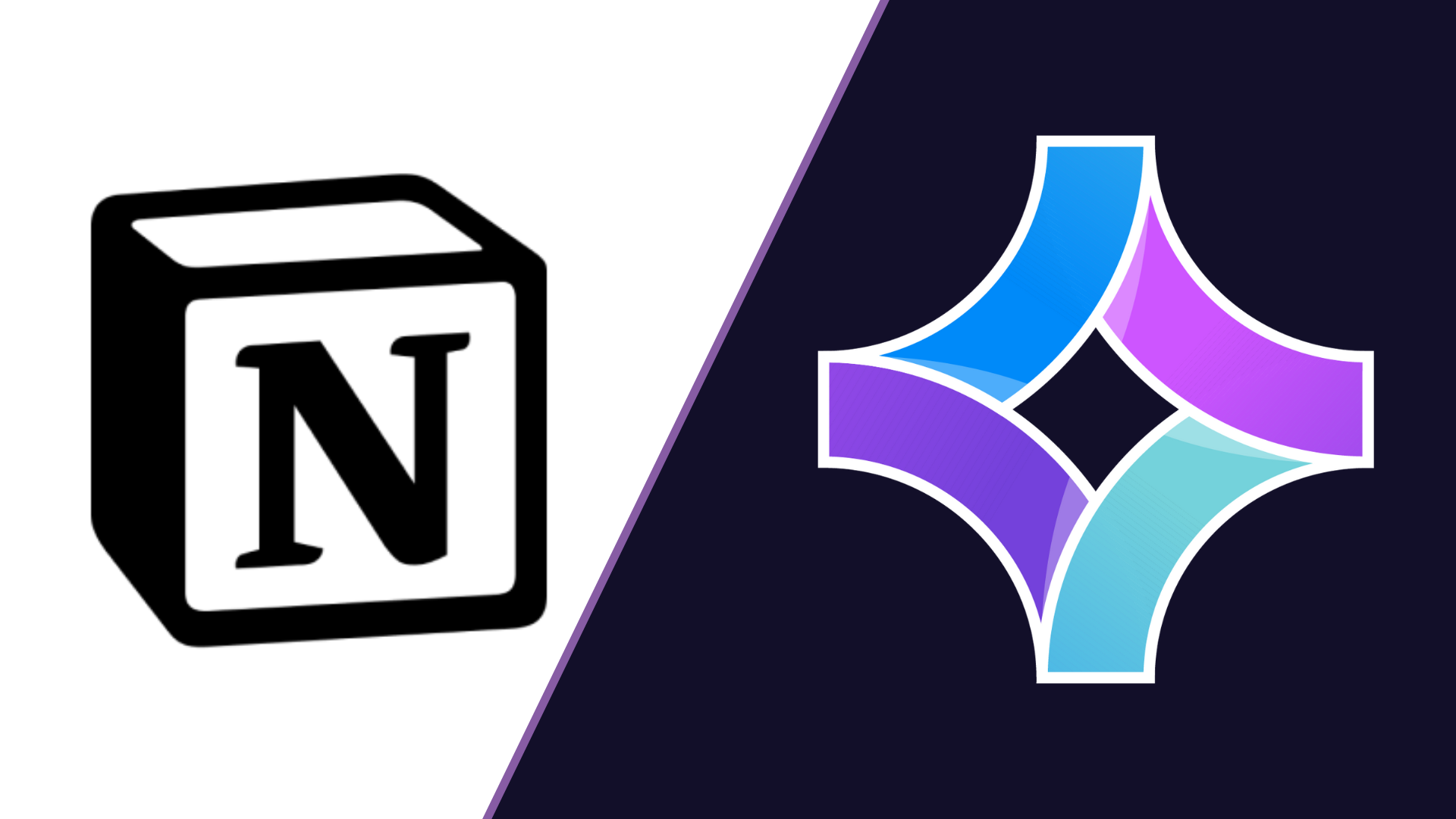
In the realm of productivity tools, Notion has garnered significant attention for its versatility and customizable interface. Yet, many users encounter challenges that compromise its effectiveness, prompting a search for more robust solutions. Teamplate emerges as a superior alternative, addressing the limitations of Notion while offering an all-in-one platform tailored to enhance productivity, streamline workflows, and facilitate seamless collaboration. This article delves deeply into the reasons why Notion falls short and how Teamplate surpasses these shortcomings, providing a comprehensive analysis that equips you with insights to make an informed decision.
Exploring the key features and benefits of Teamplate over Notion can reveal why it’s worth considering as your go-to productivity software.
Table of Contents
Key Takeaways
- Notion’s interface can be frustratingly cluttered and unintuitive.
- Teamplate offers a more user-friendly and customizable experience.
- Switching to Teamplate can streamline your workflow and improve productivity.
The Limitations of Notion

Overwhelming Complexity
Notion’s flexibility is both a blessing and a curse. While it allows for extensive customization, the sheer number of features can be overwhelming for new users. The steep learning curve requires a significant investment of time and effort to set up and tailor the platform to specific needs. For busy professionals and teams, this complexity can detract from productivity rather than enhancing it.
- Initial Setup: Customizing Notion to fit unique workflows involves a meticulous setup process. Users must create databases, templates, and dashboards from scratch, which can be daunting for those unfamiliar with the tool.
- Maintenance: Keeping Notion organized and updated requires continuous effort. As projects evolve, so must the structure within Notion, demanding regular attention to maintain efficiency.
Inefficient Collaboration
Effective collaboration is pivotal for any team, and while Notion offers collaborative features, it lacks the integrated, real-time communication tools necessary for seamless teamwork. The absence of native chat, video calls, and robust file-sharing capabilities can lead to fragmented communication and inefficiencies.
- Communication Gaps: Without integrated chat or video call features, teams must rely on external applications, leading to context switching and potential miscommunication.
- File Management: While Notion allows for file embedding, it does not provide a comprehensive solution for secure file sharing and management. Users often find themselves juggling multiple tools to meet their collaboration needs.
Performance Issues
As teams scale and projects grow in complexity, Notion’s performance can suffer. Slow loading times, syncing issues, and occasional crashes can disrupt workflows and cause frustration among users.
- Scaling Problems: Notion’s performance can degrade with the increasing volume of data, making it less reliable for large-scale projects.
- Reliability: Users report occasional syncing issues and downtime, which can hinder productivity and lead to data inconsistencies.
Limited Project Management Features
While Notion offers basic project management tools, it often falls short for teams managing multiple, complex projects. The lack of advanced features like sprint planning, and detailed task tracking can make it challenging to keep projects on track.
- Task Management: Notion’s task management capabilities are basic, lacking features like recurring tasks, dependencies, and advanced reporting.
- Project Tracking: Teams require robust tools to track progress, manage workloads, and analyze performance—areas where Notion can be insufficient.
Why Teamplate is a Better Alternative
Teamplate addresses Notion’s limitations by providing an all-in-one solution that combines the best features of leading productivity tools into a single, cohesive platform. This section explores how Teamplate excels in usability, collaboration, project management, performance, and affordability.
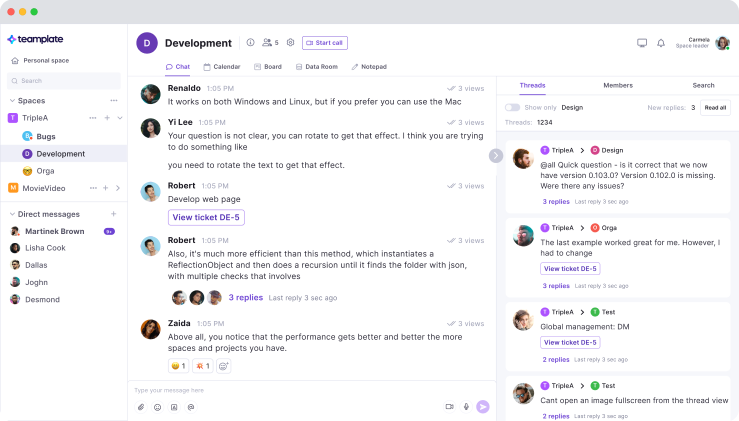
User-Friendly Interface
Teamplate is designed with the user in mind, offering an intuitive and easy-to-use interface that minimizes the learning curve and allows users to get started quickly. Its clean, straightforward design ensures that users can focus on their tasks without being bogged down by unnecessary complexity.
- Ease of Use: Teamplate’s interface is simple and intuitive, enabling users to navigate and utilize features without extensive training.
- Customization: While maintaining simplicity, Teamplate offers sufficient customization to tailor workflows to specific needs without overwhelming users.
Seamless Collaboration
Teamplate excels in fostering collaboration with built-in features that ensure real-time communication and efficient teamwork. Unlike Notion, which requires multiple applications for comprehensive collaboration, Teamplate integrates all necessary tools into one platform.
- Integrated Communication: Teamplate includes native chat, video calls, and threaded conversations, reducing the need for context switching and enhancing team communication.
- File Sharing: With robust file-sharing capabilities, Teamplate allows users to upload, share, and manage files securely within the platform, streamlining collaboration.

Key Collaboration Features
- Chat: Collaborate seamlessly with teams and clients across projects, spaces, and direct messages. Foster real-time collaboration with instant messaging, file sharing, and threaded conversations.
- Video Calls: Connect your team and clients for efficient meetings and collaboration with inbuilt screen recording and video call functionality. This feature unites remote-based teams and facilitates asynchronous communication.
- Screen Record: Record your screen and upload recordings to chats, tickets, and data rooms, ensuring that information is easily accessible and sharable.
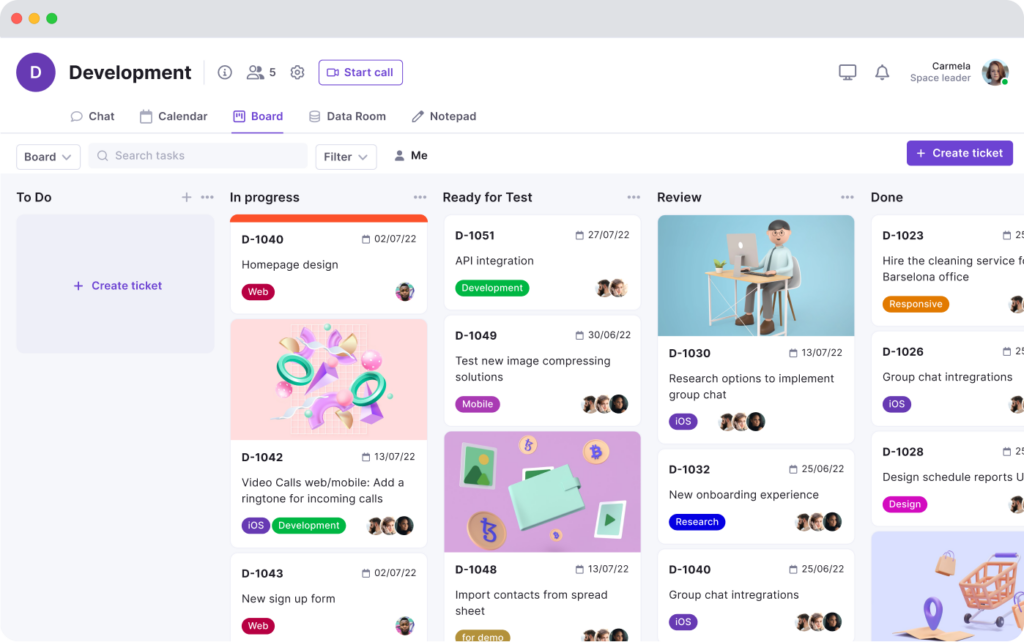
Robust Project Management
Teamplate offers advanced project management tools, providing a comprehensive view of project progress and helping teams stay organized and on schedule. Unlike Notion, Teamplate’s project management features are designed to handle complex workflows and large-scale projects.
- Kanban Boards: Organize workflows, manage tasks, and visualize progress with customizable boards, epics, and sprints. Switch between backlog, Kanban, and board views to adapt to different project needs.
- Calendar Integration: Stay on top of your schedule and manage meetings with ease, ensuring that deadlines are met, and tasks are properly scheduled.
- Dashboard: Manage your events and tasks from a dedicated space that provides an overview of your productivity metrics. This dashboard offers a bird’s eye view of a master calendar, pulling events from all spaces and projects into one place, and also allows for sorting and filtering of tasks for better organization.
Key Project Management Features
- Task Management: Teamplate offers advanced task management capabilities, including recurring tasks and dependencies ensuring that projects stay on track.
- Project Tracking: With tools to track progress, manage workloads, and analyze performance, Teamplate provides the insights needed to optimize project outcomes.
Enhanced Performance
Built to handle the demands of growing teams, Teamplate offers reliable performance with fast loading times and seamless syncing. This ensures that users can focus on their work without interruptions or delays.
- Scalability: Teamplate is designed to scale with your team, maintaining performance and reliability even as data volume increases.
- Reliability: With robust infrastructure, Teamplate minimizes downtime and syncing issues, providing a stable platform for your productivity needs.
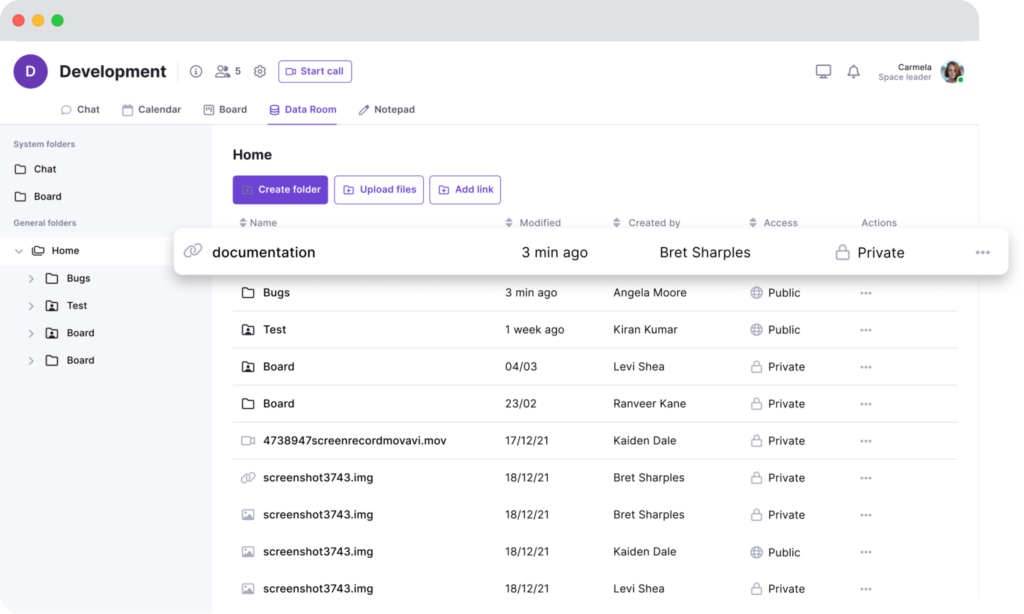
Comprehensive Data Management
Teamplate’s Data Room allows users to securely store, upload, and share various file formats, including Excel, Word, PDF, and images. Permissions can be set per file, ensuring that sensitive information is protected.
- Secure Storage: Store and manage files securely within Teamplate, with permissions settings that ensure only authorized users have access.
- File Management: Easily upload, share, and manage files within the platform, streamlining data management and enhancing collaboration.
Affordable and Accessible
Teamplate is designed to be accessible to all, offering a freemium model with all features available. This makes it an affordable option for startups, small and medium businesses, freelancers, and creative agencies.
- Freemium Model: Teamplate provides all features for free, making it accessible to teams of all sizes without the burden of multiple subscriptions.
- Cost Savings: By consolidating multiple tools into one platform, Teamplate helps users save on subscription costs and reduces the complexity of managing different applications.
Benefits for Target Audience
Teamplate is designed to meet the diverse needs of various target audiences, providing tailored solutions that enhance productivity and streamline workflows.
Start-ups
Challenges: Managing a small team efficiently with limited resources.
Benefits: Teamplate helps streamline workflows and improve team collaboration, allowing startups to focus on achieving key milestones and growing their business.
- Workflow Efficiency: Teamplate’s intuitive design and integrated features help startups manage projects and collaborate efficiently, even with limited resources.
- Growth Facilitation: By reducing the time spent on managing multiple tools, startups can focus on achieving growth objectives and scaling their business.
Small & Medium Businesses (SMBs)
Challenges: Balancing day-to-day tasks with strategic planning.
Benefits: Teamplate enhances communication and transparency, improving project management and overall efficiency.
- Operational Efficiency: SMBs benefit from Teamplate’s comprehensive project management and communication tools, which streamline operations and improve productivity.
- Strategic Planning: With advanced tracking SMBs can balance daily tasks with long-term strategic planning, ensuring sustained growth and success.
Freelancers
Challenges: Staying organized and meeting deadlines across different clients and projects.
Benefits: Teamplate improves project management and client communication, freeing up time for business development and personal branding.
- Client Management: Freelancers can manage multiple clients and projects efficiently with Teamplate’s integrated tools, ensuring timely delivery and client satisfaction.
- Time Management: By streamlining workflows, Teamplate helps freelancers manage their time effectively, allowing them to focus on business development and personal branding.
Marketing & Creative Agencies
Challenges: Managing multiple client projects simultaneously.
Benefits: Teamplate streamlines project workflows and enhances team communication, ensuring high-quality work and client satisfaction.
- Project Efficiency: Agencies can manage multiple projects seamlessly with Teamplate’s advanced project management tools, ensuring timely delivery and high-quality work.
- Client Satisfaction: With improved communication and collaboration, agencies can exceed client expectations and build strong relationships, leading to repeat business and growth.
Conclusion
While Notion offers a range of features, its complexity and performance issues can hinder productivity. Teamplate, with its user-friendly interface, seamless collaboration tools, and robust project management capabilities, provides a superior alternative that meets the needs of modern teams. By choosing Teamplate, you can boost productivity, save time and money, and empower your team to achieve their goals with greater efficiency.
Teamplate stands out not only for its comprehensive features but also for its commitment to user experience and affordability. It is designed to be a practical solution for a wide range of users, from startups and SMBs to freelancers and creative agencies, making it an ideal choice for those seeking to enhance their productivity and streamline their workflows.
Project management and team collaboration thrive on clarity and openness. It’s essential that everyone involved is fully informed and in sync .
A key strategy to achieve this is implementing the Kanban framework, renowned for enhancing transparency and streamlining work processes.
This article will introduce you to the Kanban board, a vital tool in this methodology. We will also showcase over 10 outstanding Kanban board examples, providing valuable insights and ideas for your project management endeavors.
Ready to dive in?
Let’s begin.
Table of Contents

What is a Kanban Board?
A Kanban board visually maps out your workflow using columns that denote different stages of a task’s progress. This board is a cornerstone of the Kanban method, an agile approach emphasizing team communication, ongoing enhancement, and openness.
On a Kanban board, tasks are categorized into defined queues such as “To-Do,” “In Progress,” and “Done,” mirroring the specific requirements of your workflow process.
What are the Benefits of a Kanban Board in Project Management?
A Kanban board exemplifies a fundamental yet highly effective method for tracking and managing workflows and tasks. By utilizing various color-coded cards arranged in distinct lanes, this basic Kanban board structure provides a clear and comprehensive view of ongoing projects and their current status.
The primary objective of a Kanban system is to manage and optimize workflow. By setting limits on work in progress, it ensures that team members focus on completing current tasks before embarking on new ones. This approach is crucial in preventing overload and promoting a smooth progression through the workflow.
Continuous refinement and enhancement are at the heart of Kanban, especially relevant for teams in fields like software development and marketing. With each iteration, or ‘sprint,’ teams can assess the pace of task progression, the time taken to initiate tasks, and the frequency of tasks returned for revisions or due to bugs. This ongoing evaluation, a key element of the Lean methodology and encapsulated in the Kaizen system, enables teams – whether in software development, marketing, sales, or other domains – to identify and eliminate inefficiencies, leading to better resource utilization and time management.
The versatility of Kanban boards, including online Kanban board options, allows for adaptation to a variety of team needs, from software development teams to marketing and sales Kanban boards, making them a valuable tool across various sectors.

10+ Project Management Kanban Board Examples
Get your game face on cause we’re about to play our ace by showing you some fantastic Kanban examples.
And if you’re already familiar with the rules of the game, you can start creating an online Kanban board right away – just explore teamplate Kanban board.
1. Project Management
Embarking on project management with a Kanban board isn’t just about organization – it’s about transforming abstract plans into tangible results. The first step is designing a straightforward yet comprehensive board with columns that include:
- Business Requirements
- Ready to Start
- In Progress
- Delegated to Clients
- Done
Incorporating tasks from every department onto your cards, you create a dynamic project management dashboard. This setup not only tracks what each team member is doing at any moment but also offers a panoramic view of the entire project’s progress.
On paper, this structure seems perfect. However, the true challenge lies in bringing this Kanban board to life. Relying on a physical, paper-based system might seem tempting, but in the fast-paced world of project management, this approach is as fragile as a house of cards.
To avoid the pitfalls of outdated methods, it’s essential to leverage the most efficient Kanban tools available. Take Teamplate’s Board, for example, which elevates your Kanban experience with features like:
- Effortless drag-and-drop for moving cards
- Sorting tasks by various criteria such as Status, Assignees, Priority, Tags, and Due Dates
- A comprehensive view of tasks throughout your entire Workspace
- The option to add visually appealing cover images to your cards

2. Product Management
The dynamic world of product development in industries such as SaaS, manufacturing, and software development demands versatile and adaptive management tools. Moving away from the conventional Scrum boards, these sectors are increasingly embracing the flexibility offered by Kanban boards.
Let’s delve into how different product development sectors can tailor Kanban boards to suit their unique processes:
Software Development
Stages on the Kanban board might include
- Design
- Development
- Code Review
- Testing/Quality Assurance
- Deployment
Lean Manufacturing
Here, the Kanban stages could be
- Ordered
- Scheduled
- Manufacturing
- Inspection
- Shipping
- Delivered
SaaS Development
The workflow can be simplified into stages like
- Backlog
- Work in Progress
- In Review
- Done
Kanban boards in product management serve as invaluable tools for tracking and managing critical aspects of product development. They offer real-time visibility, which is especially useful for stakeholders. For instance, when a stakeholder inquires about the status of a product, the software development team can immediately refer to the Kanban board and provide a prompt update. This level of immediacy and transparency is not just convenient; it’s crucial in today’s fast-paced business environments.

3. Real Estate
In the dynamic realm of real estate, a well-structured Kanban board can be a powerful tool for sales agents, enhancing their ability to effectively manage leads, negotiations, and oversee their entire sales funnel. Implementing a Kanban board into your real estate CRM system can revolutionize the way sales processes are handled, offering clarity and efficiency at every step.
Consider incorporating these meticulously designed stages into your sales Kanban board:
- Contacted – marking the initial interaction with potential clients.
- Interested – identifying prospects who have shown interest in the listings.
- Negotiating – the phase where terms and conditions are being discussed.
- Contract Sent – indicating that the official paperwork has been forwarded to the client.
- Contract Received – acknowledging the receipt of the contract by the client.
- Signed – the stage where the client signs the contract, signaling a commitment.
- Deal Closed – the successful conclusion of the sales process.
By integrating these stages into the sales process within your real estate CRM, your team gains unparalleled visibility into the journey of each prospective customer. This structured approach ensures that every lead is meticulously tracked and managed, minimizing the chances of missed opportunities or lapses in communication. Furthermore, this systematic method empowers your agents with the insight to determine the most opportune moments for client engagement. It goes beyond mere transactional interactions and builds towards nurturing a relationship with the client, ensuring contact is made when it is most effective and welcome, rather than at inconvenient times.

4. Construction
Kanban boards serve as a versatile and effective tool for managing and scheduling construction projects of all scales, from small to large-scale organizations. By adopting the Kanban method, construction teams can enhance their project management strategies and streamline their workflows.
Consider, for instance, the construction project lifecycle. This typically encompasses phases like
- Planning
- Initiation
- Bidding and Procurement
- Construction
- Close-out.
By utilizing a Kanban board, each of these phases can be subdivided into more granular, manageable tasks.
Taking the Construction phase as an example, it can be further broken down into specific tasks such as
- Demolition
- Framing Structure
- Pouring Concrete.
These detailed subdivisions on the Kanban board not only make the project more manageable but also provide clear visibility into each stage of the process.
In the context of marketing, a marketing Kanban board can be similarly structured to manage various aspects of a content marketing campaign. For operations teams, an operations Kanban board can streamline processes, from daily logistics to long-term strategic planning. Portfolio Kanban boards can be employed for high-level project overviews, making them an invaluable tool for senior management to oversee multiple projects simultaneously. The real power of Kanban boards lies in their adaptability. Whether you’re creating your own Kanban board from a template or using pre-designed board examples, they can be tailored to suit the specific needs of a project or team. This is particularly beneficial in agile environments, such as agile construction teams or agile marketing teams, where flexibility and responsiveness to change are crucial.

5. Student
For students juggling multiple projects and assignments, adopting an agile Kanban board can be a game-changer. It’s a practical way to organize projects, collaborate on group tasks, and keep tabs on schedules and assignments. With tools like Excel or Google Sheets, creating a personalized Kanban board template is both accessible and effective.
Consider adding these columns to your student Kanban board to efficiently track project progress:
- To-Do: List all pending tasks.
- Subject: Categorize tasks by academic subjects or project titles.
- Assigned Type: Distinguish between individual and group tasks.
- In Progress: Track ongoing tasks.
- Done: Monitor completed assignments.
When facing a substantial project, breaking it down into smaller, more manageable tasks is key. Take, for example, the assignment of reading William Shakespeare’s “Hamlet.” Instead of overwhelming yourself with the task of reading the entire play at once, divide it into segments:
- Read Acts 1 & 2
- Read Act 3
- Read Acts 4 & 5
This approach not only simplifies the task but also provides a clear path to completion.
Group projects can especially benefit from this method. Utilizing a feature like ClickUp’s Multiple Assignees, team members can divide the project into smaller tasks and assign them accordingly. This facilitates clear communication and coordination within the group, allowing each member to track progress and contribute effectively. As a result, the team can ensure that the project is progressing smoothly and is on track for timely submission.
6. Marketing
In the bustling world of content marketing, managing a myriad of tasks ranging from project deadlines to client feedback and campaign advancement is crucial. Without an effective system to track these diverse activities, it’s challenging for marketing teams to gauge their progress and efficiency.
This is where a content marketing Kanban board becomes an essential tool. It enables teams to monitor various activities seamlessly, from website design management to SEO optimization. A well-structured Kanban board for marketing teams might include stages such as:
- Backlog – a reservoir of planned tasks and ideas.
- To-do – tasks that are queued for execution.
- In Progress – current, actively worked-on tasks.
- Pending Approval – tasks awaiting confirmation or feedback.
- Rejected – tasks that require reevaluation or modification.
- Final – completed tasks that have met all requirements.
To enhance this system further, consider integrating an “In Campaign” column. This addition provides real-time insight into active promotions, allowing for prompt adjustments and optimizations.
Moreover, the application of Kanban swimlanes can elevate the organization and clarity of the board. These swim lanes allow for a visual segregation of distinct marketing activities. For instance, one swim lane might be dedicated to “Marketing Metrics,” focusing on analytics and performance tracking, while another could be for “Weekly Newsletter,” streamlining the newsletter creation and distribution process.
7. Weekly Planning
Navigating through the maze of ambitious weekly goals only to find ourselves falling short is a scenario many of us know all too well. The irony is not lost that seven days often leave us feeling, well, weak.
Enter the weekly planning Kanban board, a tool adept at transforming the often chaotic process of agile sprint planning, habit building, and task management into an organized, manageable system. Here’s a streamlined approach to setting up your weekly task board, a tool equally valuable for content marketers, project managers, and team members alike:
- Weekly Goal Setting – at the start of each week, identify and select a handful of achievable tasks from your content marketing Kanban board. This focused approach ensures that you’re not overcommitting.
- Single-Task Focus – adopt a strategy of working on one task card at a time. This method fosters deeper concentration and more efficient task completion.
- Break It Down – for every project task on your card, add subtasks. This breakdown converts overwhelming tasks into smaller, more achievable steps, aligning well with team member specialties and allowing for easier tracking and task management.
- Future Planning with Swimlanes – implement swimlanes on the same board for subsequent weeks, such as weeks two, three, etc. This setup allows for continuous improvement in your planning and provides a clear visual path for forthcoming tasks.
This weekly planning Kanban board not only aids in effective task management but also serves as a guide for project managers and teams to align their efforts with the set objectives. The clarity and structure it brings to the often hectic workweek are invaluable for maintaining focus and driving toward success.

8. Creative and Media Development
When managing complex workflows that involve creative processes, project managers and support teams often face priority conflicts. These challenges are especially pertinent when working across multiple teams and balancing numerous tasks. A practical solution to these challenges is the implementation of several Kanban boards, each tailored to distinct facets of media management.
Let’s explore how Kanban boards can be structured to streamline operations in different areas of media and content management:
Content Creation Planning Kanban Board
This board can track the progression of content from its inception to promotion with stages like
- Requested
- In Progress
- Copy Approval
- Design
- Implementation
- Promotion.
- Such a setup assists project managers in overseeing the entire content creation lifecycle.
Photoshoot Kanban Board
A dedicated board for photoshoot projects could include stages such as
- Concept
- Planning
- Scheduled
- In Progress
- Editing
- Edited
- Delivered
This allows teams to manage each phase of the photoshoot effectively, reducing the risk of priority conflicts.
Content and Social Calendar Kanban Boards
For managing content across various digital platforms, boards could be organized into stages like
- Ideas
- Scheduled This Week
- Scheduled Next Week
- Later This Month
- Published
This structure is particularly beneficial for support teams coordinating content publication across multiple platforms and timelines. These Kanban boards serve not only as tools for tracking the progress of individual tasks but also as platforms for collaborative effort among multiple teams. By clearly defining stages and tasks, they help in prioritizing and resolving conflicts, ensuring that each team member knows their responsibilities and deadlines. The visual nature of Kanban boards facilitates easier communication and a unified approach to project management, essential in the dynamic environment of creative media.
9. Personal Project Management
Kanban boards are not just powerful tools for managing successful projects within a professional context; they can also be incredibly useful for organizing personal projects, from vacation planning to home renovations. While diverse team members in a workplace might use separate boards for various tasks such as the hiring process or product development process, individuals can similarly utilize Kanban boards for their personal planning.
Let’s take vacation planning as an example, even in times when travel may be restricted, like during COVID lockdowns. A personal Kanban board can be a hopeful tool for mapping out future holiday plans. Instead of the typical project-focused columns like to-do, in progress, and done, you can customize your board to fit the nuances of travel planning. Columns might include:
- Admin – for managing bookings, travel insurance, and other administrative tasks.
- Packing – checklist of items to pack for the trip.
- Tourist Attractions – planning and scheduling visits to various sites and attractions.
- Food and Drinks – researching and noting down must-try local cuisine and dining spots.
Incorporating visual elements, such as images of beaches or destinations, into your vacation Kanban board can also add an element of excitement and motivation, especially when physical travel is limited. These images serve as a reminder of the enjoyable experiences that await and can be a delightful contrast to the mundane backgrounds we’ve grown accustomed to in virtual meetings.

10. Event Management
Kanban boards are remarkably versatile and can be a tremendous asset in planning and executing a variety of events, from enchanting weddings to dynamic work functions. Their visual nature and customizable framework make them an ideal tool for event project management.
When creating a Kanban board for event planning, the standard columns – such as To-Do, In Progress, and Done – provide a solid foundation. However, the true magic of Kanban in event planning lies in its ability to be tailored to the specific nuances of event management.
- Custom Columns for Specific Needs – apart from the standard columns, you can add specific ones like “Design Ideas”, “Vendor Contracts”, “RSVPs”, or “Day-of-Event”. These specialized columns allow for tracking different aspects of event planning in an organized manner.
- Visual Inspiration and Confirmation – adding images to your Kanban board can greatly enhance the planning experience. For instance, if you’re organizing a wedding, you can upload pictures of potential flower arrangements, cake designs, and decor themes directly onto the board. This not only serves as a visual reference but also helps in sharing ideas with others involved in the planning process.
- Pending Approval Column – a “Pending Approval” column is particularly useful for tracking items that require confirmation or approval. This can include contracts waiting to be signed, invoices needing clearance, or decisions on venue bookings. Having this column ensures that you’re always aware of what’s awaiting action, preventing bottlenecks in the planning process.
- Collaboration and Updates – for events that involve multiple organizers or stakeholders, a Kanban board can be an effective platform for collaboration. Team members can update the board with new information, track progress, and see at a glance what others are working on. This facilitates clear communication and keeps everyone on the same page.
- Flexibility and Adaptability – as event details can often change, the flexibility of a Kanban board to adapt quickly is invaluable. You can easily move tasks between columns, update details, and rearrange priorities as the planning evolves.
Whether it’s for a family gathering, a corporate event, or a celebratory occasion like a wedding, a Kanban board not only helps in organizing the myriad details involved but also makes the process more engaging and less overwhelming. It transforms the daunting task of event management into a more structured and enjoyable journey.
11. Human Resources
Investing in high-quality Kanban software apps can significantly transform the operations of an HR department, steering it away from the frantic pace often associated with fire-fighting to a more organized, efficient state. Here’s why incorporating a Kanban board into HR practices can be a game-changer:
- Streamlined Recruitment Process – an HR Kanban board can revolutionize the hiring process. Recruiters can visually map out each stage of recruitment, from initial application screenings to final interviews and offers. This clarity allows for tracking the progress of each candidate effectively, ensuring no one slips through the cracks.
- Enhanced Candidate Retention – by organizing and prioritizing tasks on the Kanban board, recruiters can respond more promptly to candidates, keeping them engaged and interested. This timely communication is key in retaining top talent, especially in competitive job markets.
- Maintaining Recruiter Sanity – the organized nature of a Kanban board can significantly reduce the stress and chaos that often accompany recruitment. By having a clear overview of all ongoing processes, recruiters can manage their workload more effectively, leading to a less frenetic, more controlled work environment.
- Improving Candidate Experience – the efficiency brought about by the Kanban system directly impacts the candidate experience. Faster response times, transparent communication, and a streamlined process make for a more positive interaction with potential employees. A smooth and professional recruitment process reflects well on the company’s brand and increases the likelihood of candidates accepting offers.
- Collaboration and Visibility – kanban boards foster better collaboration among team members. Everyone in the HR team, from recruiters to hiring managers, can view the progress of various tasks and understand their roles and responsibilities in the recruitment process. This shared visibility promotes a cohesive team effort and reduces the chances of miscommunication.
- Continuous Improvement – with the Kanban methodology, there’s always room for refinement. HR teams can regularly review and adjust their processes, responding to changes in the recruitment landscape or internal company policies. This adaptability is crucial for maintaining an efficient and effective hiring process.
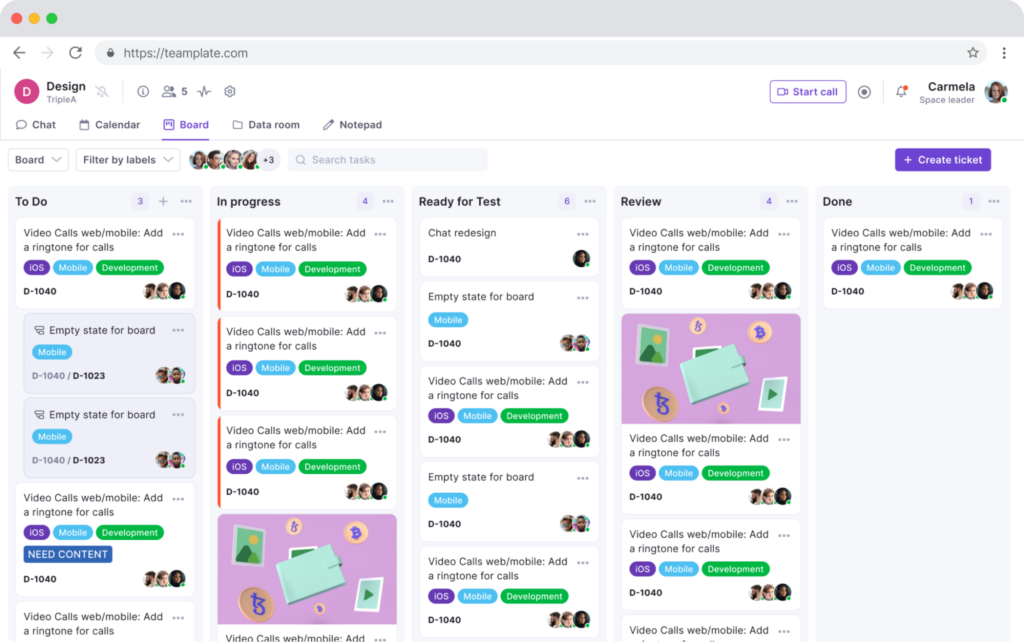
Conclusion
The adoption of a Kanban board in various departments, particularly in HR, can lead to transformative changes in efficiency, communication, and overall workflow management. The benefits of utilizing such a system are extensive: from streamlining recruitment processes to enhancing candidate experience, and from maintaining team sanity to fostering continuous improvement.
For organizations looking to implement this system, Teamplate offers a robust Kanban board solution that is worth exploring. Their platform is designed to cater to the diverse needs of different teams and projects, making it an ideal choice for those seeking to enhance their productivity and organizational capabilities. By integrating Teamplate’s Kanban board into your workflow, you open up opportunities for greater collaboration, transparency, and efficiency. It’s a step towards not just organizing tasks but optimizing entire processes, ensuring that your teams are working at their best and delivering exceptional results.
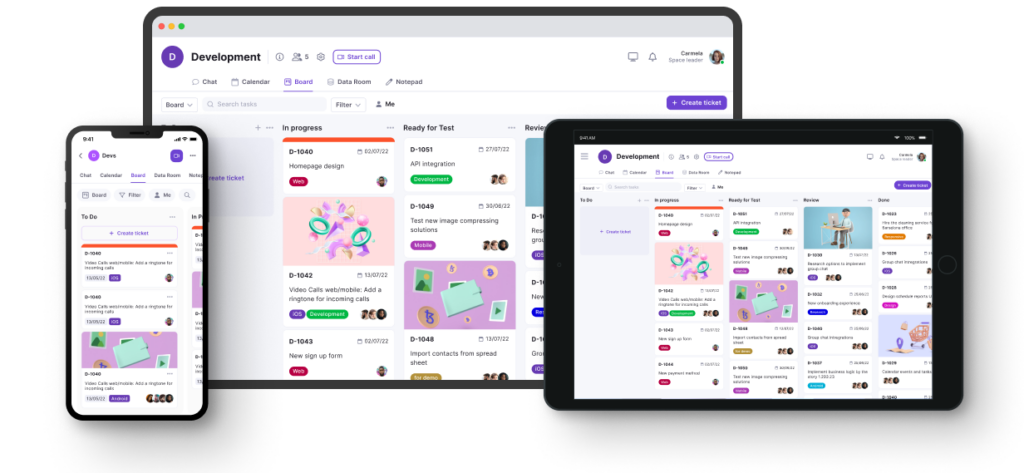
Success in today’s fast-paced business world relies on efficiency and structure, making free project management software a valuable asset. This tool streamlines corporate processes by acting as a centralized hub for managing tasks, schedules, and resources, bridging the gap between planning and execution. Its significance extends across industries such as retail, IT, healthcare, and construction, enhancing productivity and ensuring precision in meeting project milestones.
Effective project management software is crucial for managing resources, maintaining oversight, and adapting to changing demands. It helps meet deadlines, stay within budget, and satisfy stakeholders.
This article highlights the benefits of free project management software. While paid solutions offer more features, free options provide an accessible starting point for small businesses and startups to optimize operations without financial strain. Equipped with capabilities to handle multiple projects, these tools enable organized task management and informed decision-making.
We will explore how to use free project management tools to manage recurring tasks and improve efficiency in any business environment. This software can be a game-changer for project managers navigating modern business complexities.
Table of Contents
Why Choose Free Software?
There’s a strong allure for free project management software in the realm of task management solutions, drawing keen interest from businesses, especially startups and small enterprises, due to its array of benefits.
The primary advantage of free management software lies in cost savings. This kind of software provides essential project management features without financial burden, a boon for startups and small businesses operating on lean budgets. Even smaller teams can harness these tools for enhanced workflow procedures and organized task management. Many free project management apps offer a risk-free introduction to various job management solutions. Businesses can experiment with different free project management tools without financial commitment, an invaluable method for finding the right mix of project management features and user experience.
Typically, free task management software is more agile and user-friendly, necessitating minimal setup. They are ideal for firms needing a straightforward approach to project management, offering core functionalities like the ability to track tasks, manage team collaboration, and handle multiple projects. However, there are concerns with free software, particularly in its range of functionalities compared to paid versions. Free tools might have limitations in storage, integrations, or customization. The quality and frequency of updates and support for free project management software tools are also a common concern, as it can impact the tool’s longevity and efficiency.
Despite these challenges, free project management software can be the perfect choice in various scenarios:
- For startups and smaller teams, free project management tools provide essential job management features without significant financial investment. They offer the ability to create tasks, track task dependencies, and handle unlimited tasks and users.
- Organizations unsure about their specific project management needs can leverage free tools to explore different functionalities and find what works best for them, especially in managing recurring tasks.
- Charities and non-profits, often working with constrained budgets, find great value in the cost-saving aspect of free project management apps.
- For short-term projects or one-off events, using free software can be a practical approach, avoiding long-term commitments and allowing project managers to efficiently manage multiple projects.
Top Free Job Management Software Options
Teamplate

Teamplate distinguishes itself as a powerful player in the world of project management tools, offering a suite of well-designed features that set it apart from competitors. These features are thoughtfully engineered to streamline task management, making it simpler to manage varied project aspects such as checklists, epics, and sprints. This forward-thinking methodology revolutionizes project management, ushering in a new level of efficiency and organization.
At its core, Teamplate brings an extensive range of functionalities that enhance project management with both precision and efficiency. It’s adept at serving teams of various sizes, empowering them to manage projects with remarkable finesse and agility. Going beyond basic project management functionalities, Teamplate presents a unified platform that evolves with the dynamic needs of team collaboration and project development.
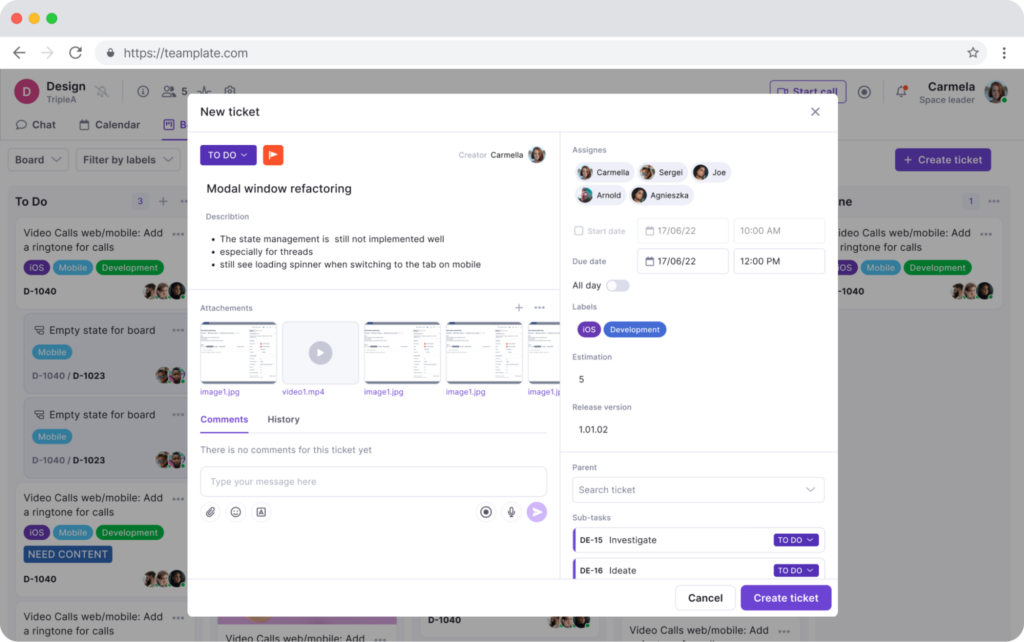
Key Features
- Teamplate streamlines the management of epics, enabling teams to effortlessly create and track them while gaining a holistic view of project progress and a deeper grasp of project objectives.
- Emphasizing the importance of timing in project management, Teamplate’s sprint functionality lets teams divide their work into manageable segments, focusing on distinct tasks within specific time frames. This method not only heightens productivity but also aids in keeping track of how the project evolves.
- By integrating agile methodologies, Teamplate excels beyond standard tools, making it ideally suited for teams operating in dynamic project environments.
- With a user-focused interface, Teamplate simplifies task management, avoiding the complexities often found in other software. This makes it an ideal solution for businesses of all sizes.
- The checklist feature in Teamplate is designed for meticulous task breakdown, offering detailed management and control, ensuring tasks are thoroughly overseen and executed.

Advantages of Teamplate
- The harmonious integration of checklists, epics, and sprints in Teamplate offers unparalleled adaptability in managing projects, reducing unpredictability in their execution.
- The application of agile methodologies in Teamplate ensures swift adaptation to changing project scenarios.
- Its intuitive interface ensures ease of use, allowing for quick onboarding and seamless functioning.
- Teamplate enhances teamwork by providing easy to use tools that foster efficient communication and collaborative decision-making.
Pricing
- Available as a “Free Forever” plan.
ProofHub
ProofHub stands out as a notable alternative among various teamwork-focused project management tools. It centralizes project management activities, offering an all-in-one solution. Its features include task boards for efficient work organization, discussion threads for team communication, and an integrated calendar for deadline tracking. This project management tool is both user-friendly and cost-effective, making it an ideal option for teams aiming to enhance their workflow, monitor project progress, utilize Gantt charts, and handle complex tasks.
Advantages of ProofHub
- Provides essential project delivery tools like Gantt charts and Kanban boards, catering to the needs of diverse teams.
- Incorporates features for time tracking and invoicing, as well as other financial management tools, making it a well-rounded solution for project management.
- Facilitates integration with popular cloud storage services, enhancing accessibility and storage options.
- Offers a dedicated mobile application designed specifically for the needs of project managers on the go.
- Comes equipped with native tools for collaboration and discussion, promoting efficient communication within teams.
Limitations of ProofHub
- Encounters limitations in its ability to integrate with commonly used business applications and software.
- The availability of training materials is somewhat restricted, which could pose hurdles in project management for certain users.
Pricing
- Essential: $45/month per user
- Ultimate Control: $89/month per user
Freedcamp
Among various project management systems, Freedcamp stands out as a straightforward yet effective substitute, providing a hassle-free method of project administration. It has the basic functions of a project management tool—such as task management, time tracking, and a calendar view—that project managers frequently look for. It is quite simple to manage tasks and track project progress with this arrangement.
Advantages of Freedcamp
- In Freedcamp, task lists play a pivotal role, allowing teams to delegate and monitor tasks, keep tabs on project advancement and status, and distribute key resources such as documents and images among different tasks.
- Freedcamp incorporates a team calendar on its interface, crucial for team members to see all their tasks and priorities at a glance, aiding in effective scheduling and organization.
- Additionally, the platform offers time management tools, enabling the tracking of time spent on individual tasks and the generation of invoices when required.
Limitations of Freedcamp
- Relative to other project management tools, the simplicity of Freedcamp’s dashboard might lead to some difficulty in quickly finding key functions like discussions and reporting, often necessitating a search.
- In comparison with its counterparts, Freedcamp provides a more limited range of built-in integrations, potentially restricting its versatility in more extensive project management contexts.
Pricing
- Free: Unlimited projects and tasks
- Minimalist: $1.49/month per user
- Business: $7.49/month per user
- Enterprise: $16.99/month per user
Microsoft Teams
Microsoft Teams is a very notable platform for communication as well as one of the top options for teamwork when it comes to all-inclusive project management. It excels at task management and seamlessly interacts with the whole Microsoft Office Suite, making it a powerful tool for project management and planning. As an alternative to teamwork, Teams offers file sharing, video conferencing, and customized collaboration areas. These features elevate Teams beyond a simple chat tool, elevating it to the top project management solution for teams looking to manage projects effectively.
Advantages of Microsoft Teams
- Features streamlined connectivity with other Microsoft applications like Word, Excel, and PowerPoint, vital for efficient project planning and task handling.
- Enables live collaboration on documents, an essential attribute for teams working on intricate projects.
- Provides capabilities for video conferencing and screen sharing, bolstering communication and cooperative efforts, which are fundamental to top-notch teamwork.
Limitations of Microsoft Teams
- For bigger teams, the cost of subscription plans may be a significant factor, particularly in contrast with other leading teamwork solutions.
- The possibility of encountering compatibility challenges becomes apparent if a team’s tech stack extends beyond solely Microsoft products and tools, a crucial aspect to weigh in when evaluating the comprehensive toolkit needed for proficient project management.
Pricing
- Free: Basic features with limitations
- Microsoft 365 Business Essentials: $4/per user/month
- Microsoft 365 Business Basic: $6/per user/month
- Microsoft 365 Business Standard: $12.50/per user/month
Taskworld
Taskworld stands out as a unique approach to project management, especially when it comes to cooperation. It emphasizes improving team member communication and task management. It offers a single platform where you can assign work, create visual project schedules, and communicate with your team.
Advantages of Taskworld
- Taskworld simplifies and refines task management, offering teams a straightforward way to follow project development, with useful checklists to gauge progress on individual tasks.
- With its user-friendly project dashboards, Taskworld ensures easy comprehension and swift navigation, thereby boosting team efficiency and positioning it as a top alternative for teamwork.
- It incorporates essential functionalities such as time tracking and Gantt charts, indispensable for overseeing ongoing tasks and maintaining vigilant oversight of deliverables and schedules.
Limitations of Taskworld
- The platform would gain from expanding its array of integrations with external applications, a crucial feature in all-encompassing project management systems.
- Users of Taskworld might face obstacles when importing data from other platforms and tools, presenting a potential drawback for those switching from various project management systems.
Pricing
- Free: Basic features with limitations
- Premium: $8/month per user
- Business: $15/month per user
- Enterprise: Contact for pricing
Podio
In the arena of straightforward project management, Podio excels with its exceptionally adaptable platform, providing a distinct environment where users can tailor their ideal work management system. The standout feature of this tool is the capability for users to create custom workflows, offering a truly individualized management experience.
Users have the liberty to pick modules that align with their requirements, weave in their preferred apps, and even tailor their dashboards to fit their tastes. Adding to its adaptability, Podio boosts team interaction with its built-in chat and video capabilities, fostering a culture of openness and collective effort.
Podio focuses on granting users the autonomy to shape their work management in ways that best suit them, positioning it as a top choice for organizations that value a balance of adaptability and oversight in their operational procedures.
Advantages of Podio
- Provides highly adaptable and user-friendly project dashboards, streamlining the process of setting up and automating tasks, particularly those that recur frequently.
- The platform features an elegantly crafted user interface, perfectly suited to meet the demands of straightforward project management.
Limitations of Podio
- There is an apparent shortfall in the frequency of updates and the introduction of new functionalities.
- Customer service is primarily available to clients with enterprise-level subscriptions.
- Users might encounter occasional interruptions in service.
- Information tends to stay compartmentalized within different applications, limiting its applicability throughout the platform.
- The platform’s design is not fully adapted for mobile devices, which can be problematic in work settings that heavily rely on mobile technology.
Pricing
- Free
- Plus: $14/month per user
- Premium: $24/month per user
Binfire
Software development teams, especially those engaged in agile project management, have certain demands that are well-met by Binfire, a dynamic project management platform. This all-inclusive project management tool is one of the greatest Jira substitutes on the market right now because of its wide variety of features. Advanced task management tools, an interactive Gantt chart, and a Kanban board are some of Binfire’s key features. Complex project management situations are made possible by the smooth integration of these components. Additionally, it has all of the collaborative tools required to manage both small and large-scale projects effectively. A standout feature of Binfire is its capacity to simulate a virtual office setting. This proves especially beneficial for teams practicing agile project management, enabling seamless collaboration regardless of geographical distances. Significantly, Binfire’s effectiveness in managing collaborative projects has been demonstrated by extensive remote teams operating across three continents, highlighting its proficiency as a multifaceted project management resource.
Key Features of Binfire
- Crucial for managing and coordinating various facets of project management.
- These functionalities are key in ensuring efficient task allocation and planning within project management applications.
- Features like the Interactive Whiteboard and Project Template are particularly suited for teams that implement agile project management strategies.
- Tools such as the Project Status Report, Interactive Gantt Chart, Activity Stream, and Burndown Chart are indispensable for software development teams tackling intricate project management tasks.
Limitations of Binfire
- A possible limitation for users in need of comprehensive integration with additional applications.
- Could pose difficulties for novices, particularly when contrasted with other project management solutions.
Pricing
- While Binfire doesn’t offer a free plan, it starts at $6.50 per user per month. Those interested in exploring its capabilities as one of the best Jira alternatives can take advantage of this pricing model to access its comprehensive project management functionalities.
Basecamp
Basecamp excels as a task management tool with a user-friendly interface, making it a top choice for managing complex projects. It’s particularly well-suited for teams that need a break from the steep learning curve of Jira, especially those not primarily focused on developer-centric tasks like bug tracking. For teams in search of a straightforward project management solution to collaboratively tackle projects, Basecamp stands out as an effective alternative to Jira. It not only offers a flexible pay-as-you-go pricing model but also comes with an annual package for those looking to utilize its full range of advanced project management features.
One of Basecamp’s key strengths is its pricing model, which does not depend on the number of users. This allows teams to involve unlimited members without incurring extra costs, making it one of the best task management software options for collaborative work. Users find Basecamp intuitive for assigning tasks and tracking the progress of project tasks, even when juggling multiple projects. Basecamp is especially advantageous for geographically dispersed teams, providing functionalities that greatly improve remote project management. As a versatile project management app, it elevates work agility and productivity, adeptly meeting the demands of various project management teams and streamlining the execution of complex projects with its comprehensive task management features.
Key Features of Basecamp
- Enhances team interaction and dialogue.
- Enables straightforward retrieval of project resources.
- Perfect for managing to-do lists and monitoring tasks.
- Automated Check-in Queries: Simplifies the process of daily team meetings.
- Offers clients and customers a clear view of tasks and facilitates effective communication.
- Group Messaging & Personal Chats: Boosts cooperative efforts among team members.
- Reporting on Tasks: Delivers valuable information on task fulfillment and overall project development.
Limitations of Basecamp
- Omission of Time Tracking Feature: A significant limitation of the system.
- Limits adaptability in managing tasks and projects.
- No Inherent Dependency Management: This shortfall hampers the handling of intricate projects.
Pricing
- Basecamp offers a complimentary personal plan, with a paid plan priced at $99/month for unlimited users, making it a cost-effective solution for managing multiple projects.
Pivotal Tracker
Pivotal Tracker distinguishes itself as a key agile project management tool, designed to optimize task creation and bolster team collaboration. This platform, noted for its straightforward and user-friendly interface, competes well with Jira, providing simple project management with a suite of advanced features. At the heart of Pivotal Tracker’s functionality is its capacity to offer a clear perspective on project priorities, assisting teams in identifying the next tasks to tackle. This positions it as a strong Jira alternative, especially with its incorporation of features like backlog lists and quick fix options, which streamline task assignments in agile software development. A standout aspect is its team velocity calculation, gauging progress through completed story points in each cycle, providing a tangible measure of the project’s progress.
Enhancing its core features, Pivotal Tracker aids in planning with its specialized tracking tool, breaking work down into achievable segments. This is crucial in managing task dependencies and keeping track of project timelines, making it a comprehensive task management app. Its integration capabilities with tools like Google Calendar and use of Gantt charts and Kanban boards further streamline the process, ensuring that personal tasks, due dates, and overall progress are tracked efficiently and transparently.
Key Features of Pivotal Tracker
- Helps in collaboratively estimating and setting priorities for tasks.
- Promotes a smooth and efficient workflow.
- Enables the effective handling of multiple projects at once.
- Monitors time and patterns, yielding essential insights.
- Supports cyclical planning and continuous monitoring of tasks.
Limitations of Pivotal Tracker
- Not optimal for projects that are non-agile or extensive in scale.
- The interface may seem overcrowded and less user-friendly to certain users.
- The constrained reporting capabilities hinder the production of in-depth analytics.
Pricing
- Pivotal Tracker offers a free plan for up to five users, making it an accessible option for smaller teams. For larger teams, the paid plans begin at a reasonable $10 monthly flat rate. This pricing structure, combined with the option for a free trial, makes Pivotal Tracker an attractive choice for those seeking efficient and budget-friendly project management tools.
Asana
Asana, a free project management tool, offers a Kanban-style board view, making it an excellent option for visually-oriented project management. This functionality, coupled with its workflow automation, is pivotal in organizing tasks and enhancing project planning efficiency. The software’s ability to manage task dependencies also makes it suitable for handling complex projects. One of Asana’s key attributes is its provision for multiple workspaces, which allows users to assign tasks, add important documents, and facilitate collaboration among team members in real-time. Its transparency in displaying co-workers’ tasks and priorities is essential for maintaining agility and efficiency in any project. Asana’s versatility across various devices and browsers aids in consistently tracking projects’ progress.
With Asana, the dependence on external applications or emails for team communications is greatly reduced. Utilizing this management software tool enables teams to significantly boost workflow efficiency, track projects more effectively, and improve overall project execution. The platform’s project templates, ability to create custom fields, and collaboration features ensure that all team members are on the same page. Furthermore, Asana is distinguished by its robust tech support, accessible through multiple channels, enhancing its usability for both professional and personal projects. The free version of Asana includes essential features like Kanban boards, the ability to track progress, set due dates, and manage tasks with custom fields, making it a comprehensive solution for project management.
Key Features of Asana
- Several Workspaces: Enhance the effectiveness of managing projects.
- Maintain a comprehensive record of all project-related actions.
- Offer convenient access to crucial documents.
- Calendar Feature: Useful for proficiently monitoring time and managing deadlines.
Limitations of Asana
- Absence of Inherent Messaging: Lacks the capability for instant messaging, essential for prompt collaborative work.
- Restricted Sophisticated Functions in Free Versions: Advanced elements like timelines and customizable fields are reserved for premium plans.
- Project Complexity Fit: Better aligned with straightforward project management and might fall short in managing exceedingly intricate projects.
Pricing
- Asana offers a free plan. Their paid plans start from $10.99/user per month.
Conclusion
This investigation of free job management software has covered a wide range of choices catered to different company requirements, including some noteworthy mentions such as Teamplate. There are many resources available to improve project efficiency and organization, from the simplified task management and team collaboration provided by these tools to the specialized capabilities catering to both basic and complicated projects. As the reader, we strongly advise you to assess your unique needs carefully and to take into account free work management software as a first step toward streamlining your business operations. There is probably a solution that precisely fits your operating demands, whether it is the simplicity of other tools or the versatility of Teamplate.
As we come to an end, it’s critical to consider how work management software and technologies are always changing. Even more sophisticated solutions may soon surpass what we consider creative and successful now. Being aware of the changes in this constantly shifting environment is essential. Recall that the appropriate tool can offer a scalable solution that expands with your company in addition to streamlining your ongoing initiatives. Continue to learn and grow, and allow technology to improve your project management experience.
A project management calendar is an indispensable tool, streamlining the planning and coordination of project tasks with remarkable efficiency. It offers a comprehensive visual representation of your team’s workload, ensuring clarity in understanding deadlines, individual responsibilities, and the current status of the project.
The question then arises: how does one craft a project management calendar that effectively caters to the specific requirements of your team?
This blog post aims to guide you through the intricate process of developing a project management calendar. This calendar is not just a mere organizational tool; it is designed to foster team collaboration and boost overall productivity. Our guide is meticulously crafted to cater to both experienced project managers and novices alike, offering valuable strategies and insights that simplify the project planning process. With this guide, navigating through your project’s planning phase will become a more streamlined and less daunting task.
Table of Contents
What Is A Project Management Calendar?
A project calendar, also known as a project planning calendar, serves as an instrumental framework for orchestrating the timeline of a project. It facilitates meticulous planning of crucial project milestones and aids in ensuring timely delivery.
However, it’s important to note that a project management calendar is just one component of a quartet of calendars integral to effective project management.
Let’s explore the others:
- Base Calendar: This is the foundational template upon which all other calendars are constructed. It delineates the standard working hours and days for the project, including distinctions between working and non-working days.
- Resource Calendar: This calendar is pivotal in mapping out the utilization of various resources, both human and material, throughout the lifespan of the project.
- Task Calendar: Dedicated to specific or exceptional tasks that do not conform to the routine parameters of the project, this calendar is crucial for managing unique assignments.
This multi-calendar approach ensures a comprehensive and nuanced view of the project’s progression.
Nevertheless, amongst these diverse calendars, the project management calendar stands out as the most vital for the overall orchestration of the project.
For those in project management seeking to optimize their workflow, exploring various calendar applications can be highly beneficial. These tools offer innovative ways to keep your project on track and well-coordinated.
Benefits of a Project Management Calendar
Project management calendars are essential tools that serve three critical functions:
- Task Scheduling: The primary function of a project calendar is to sequence project tasks in a logical and efficient order. This structured arrangement ensures clarity in task progression, enabling team members to know exactly which task to tackle next. With a well-organized project calendar, project flow can be maintained with minimal direct oversight, allowing project managers to focus on broader aspects of the project over a relaxing cup of coffee.
- Resource Allocation: In the realm of task management, a project planning calendar provides invaluable insights into the schedules of team members for the foreseeable future. This foresight is vital for crafting a project proposal and plan, especially considering the varying availability of team members, key executives, or other resources. With this visibility, project managers can adeptly schedule tasks, ensuring that team members are assigned responsibilities only when they are fully prepared to handle them. This level of resource management is fundamental to the success of complex projects.
- Timely Delivery: A project management calendar is instrumental in recording and tracking project milestones. It not only marks these key progress points but also assists in anticipating potential obstacles, allowing for strategic planning to mitigate delays. This proactive approach significantly enhances the accuracy of final delivery estimates. The importance of a project planning calendar in ensuring timely completion of projects cannot be overstated.
Project Management Calendar Tools
Here are some commonly used project management calendar platforms:
Microsoft Excel
The ubiquity of Excel in various business settings might suggest its suitability as a default tool for project management calendars. However, this assumption merits a closer examination.
While Excel is capable of creating calendars for long-term timelines or straightforward projects, its utility in managing the dynamic and day-to-day aspects of project execution is questionable. The process of setting up a calendar in Excel is akin to constructing one in Google Sheets or Google Docs – it demands manual input and customization.
Moreover, Excel’s cell sorting functionalities may not align seamlessly with the requirements of all project types, often necessitating a deeper dive into more complex features such as ribbons, modules, and even coding. This level of complexity can become a hurdle, especially considering the limited capabilities of Excel’s mobile versions, which fall short of the functionality expected from a dedicated project calendar application.
The reliance on Excel in many teams is less about its efficacy and more about its familiarity. This preference from project managers often trickles down to their teams, creating a perceived obligation to utilize Excel. Yet, one must question the practicality of this choice – does a software engineer or a designer truly benefit from updating tasks in Excel?
Ultimately, the reliance on Excel for project management may stem more from habit than from its suitability for the task. For those exploring alternatives, there are numerous options available, including tools specifically designed for creating calendars, such as Microsoft Word, and other Excel substitutes that may offer a more tailored experience for project management needs.
Google Calendar
If your team is already utilizing Google Calendar for scheduling meetings and appointments, it’s natural to consider expanding its use to encompass project management.
Google Calendar’s status as a widely adopted component of the Google suite is certainly justified, particularly for its efficiency in providing automatic reminders for upcoming projects. However, when it comes to its utility as a primary tool for task management within the realm of project management, there are notable limitations.
A significant missing feature is the ability to handle task dependencies. Google Calendar lacks an effective mechanism to interlink tasks within projects, offering only a superficial overview of due dates without delving into the details of individual tasks.
Furthermore, the platform presents challenges in maintaining an organized record of project-specific information, such as details, attachments, and to-do lists. The inability to create separate calendars for distinct projects compounds these limitations, confining users to a default calendar view, which can be restrictive and inefficient for complex project management.
Consequently, for teams engaged in serious collaborative work, relying solely on Google Calendar for project management may prove inadequate. The platform’s strengths lie in its capacity for scheduling and reminders rather than as a comprehensive solution for managing intricate project tasks and dependencies.
Microsoft Project
In the realm of project management, the significance of a well-structured project calendar cannot be overstated. As project managers navigate the complexities of multiple projects, the need for effective project management tools becomes paramount. These tools, particularly project calendars, play a crucial role in organizing and maintaining a clear project timeline.
Creating a project calendar involves more than just marking dates; it’s about integrating project details, deadlines, and milestones in a coherent and accessible manner. The right project management software can streamline this process, offering templates and features that simplify the creation of a project calendar. With these templates, project managers can efficiently assign tasks, prioritize them, and keep track of the overall project schedule.
For handling multiple projects, the utility of other project management tools becomes evident. These tools often come equipped with features that allow for a seamless transition between different project calendars, ensuring that each project’s timeline and specifics are meticulously managed.
The role of a project manager in this context is not just to oversee but to actively engage in the structuring and updating of these calendars. By effectively utilizing a project calendar template, project managers can ensure that every team member is aware of their assigned tasks and the priority level of these tasks.
In summary, the integration of project calendars into project management software enhances the ability to manage project schedules, assign and prioritize tasks, and maintain a detailed and accurate project timeline. This integration is essential for the successful management of multiple projects, enabling project managers to keep a pulse on every aspect of their projects.
What’s the Best Project Calendar Software?
Don’t download a new tool just for creating project calendars when you can manage your entire project on Teamplate!

Teamplate offers a complimentary project management calendar, tailored to cater to the unique demands of remote teams and Agile projects, along with their diverse ambitions.
At the heart of Teamplate’s offering is the Calendar View, a tool expertly designed to provide a clear visual representation of critical deadlines and strategic plans. This feature is instrumental in ensuring the timely completion of project tasks, allowing for efficient tracking and management.
The Project Management Calendar template from Teamplate stands out as a comprehensive solution for organizing and overseeing all project activities. This template serves as a centralized hub, simplifying the management process by bringing together various project elements in a single, easily accessible location. It’s an invaluable resource for teams looking to streamline their project management processes and maintain a clear overview of their project timelines.
Teamplate enhances calendar management through its intuitive and comprehensive features, tailored to meet the needs of entire teams.
The key distinction between Teamplate and traditional calendar apps lies in its fluid integration with team workflows. Teamplate allows for the breakdown of large projects into more manageable segments. By adding start and due dates to tasks in the Teamplate Task List, it automatically generates visual milestones on the calendar. This integration enables users to easily drag and drop unscheduled tasks into their appropriate time slots, aligning them with the dates set for their respective parent lists.
The Calendar view in Teamplate offers a high-level perspective of task management, organized by day, week, and month. This view not only helps in visualizing the project schedule but also allows users to delve into the specifics of each task. By clicking on a calendar task, users can access detailed information including comments and attached files, thus facilitating a more informed approach to task management.
Teamplate’s Resource Management calendar functionality is particularly noteworthy. It provides real-time insights into resource availability, ensuring that task workflows are planned with an accurate understanding of available resources. Furthermore, the addition of Time Estimates to tasks enhances project timelines, as dropping these tasks onto the Teamplate Calendar automatically incorporates the time required for their completion.
Scheduling tasks without predetermined deadlines is also simplified in Teamplate. The platform conveniently displays unscheduled tasks, which can be seamlessly integrated into the calendar. This feature is particularly useful for managing tasks across various projects and lists.
Teamplate’s calendar functionality extends beyond task management, offering a centralized platform for coordinating the broader activities of a company. It enables easy identification and adjustment of overlapping events across different departments, facilitating better coordination and decision-making. Whether it’s about adjusting schedules or seizing the opportunity to attend multiple events, Teamplate provides the flexibility and oversight necessary for effective company-wide event management.
Create your Team’s Project Management Calendar with Teamplate!
With a project calendar in place, project team collaboration will be far better than it’s now.
But even if you have the greatest system in place, that doesn’t mean you’ll get the job done.
You’ll still have to follow what the calendar says and do the work.
And if you need help with that, there’s Teamplate!
For those who are facing challenges with Jira and looking for a different solution, we have exactly what you need.
Our team has meticulously compiled a comprehensive list of 16 top alternatives to Jira for managing projects and keeping track of tasks.
You’ll find a diverse array of options in our selection, each with unique features to match your specific project requirements and budgetary considerations. Our assortment encompasses everything from cloud-based platforms and open-source options to self-hosted systems and traditional workflow management tools. Dive in to explore and choose the ideal option for your team!
Continue reading to identify the most suitable Jira substitute that aligns with your team’s needs.
Table of Contents
What is Jira?
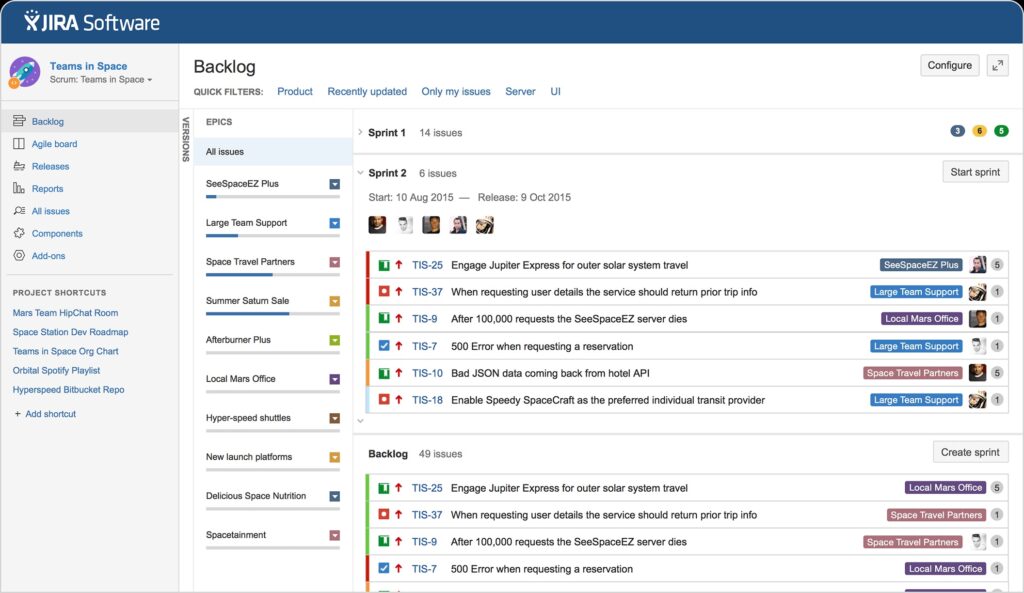
Atlassian’s Jira stands out as a highly valuable resource in the realm of agile project management. This software significantly enhances team collaboration, offering straightforward communication channels for effective engagement.
For a comprehensive evaluation, please refer to our full review of Jira.
Key Features of Jira Software:
- Seamless integration with various external systems
- Detailed insights into team activities
- Configurable permission settings for enhanced security and control
- Support for completing scrum projects efficiently
- Customizable workflows to suit specific project requirements
- Advanced incident investigation capabilities, vital for release management
- Comprehensive bug tracking functionality
- Extensive adaptability with the addition of countless custom fields
Undoubtedly, Jira presents itself as an exceptionally versatile tool for project management.
Nevertheless, exploring alternatives to Jira is a sensible approach for several reasons, which we will discuss further.
What Features to Look for in a Project Management Tool Like Jira?
In the search for a suitable Jira alternative, it’s essential to consider a range of pivotal features that ensure a seamless project management experience. Key elements to focus on include:
- An effective alternative should boast advanced project planning and scheduling capabilities. This encompasses task creation and management, deadline setting, resource allocation, and progress tracking.
- Opt for a tool that augments team collaboration and communication. Essential features should include commenting, @mentions, file sharing, and real-time messaging capabilities.
- For teams adhering to agile methodologies, select a tool that comprehensively supports these practices. Key functionalities should include kanban boards, scrum boards, effective backlog management, and detailed burndown charts.
- The ability to tailor workflows, fields, and dashboards is crucial in a project management tool. Choose a solution that offers extensive customization to align with your team’s unique requirements.
- Assess the tool’s ability to integrate with other essential software and tools used by your team. Essential integrations might include popular platforms like Slack, GitHub, Zendesk, among others.
- A competent project management tool should offer in-depth reporting and analytics features. Look for the capability to generate customizable reports, monitor team performance, and provide insightful project progress analysis.
- The usability of the tool is a critical factor. A tool with a straightforward, intuitive interface is preferable, ensuring ease of navigation and effective utilization by all team members.
16 Best Jira Alternatives in 2024
1. Teamplate

Teamplate distinguishes itself as a formidable alternative to Teamwork, emerging as a versatile project management platform renowned for its comprehensive suite of sophisticated features. These features are intricately designed to streamline task management, enabling teams to handle various project elements such as checklists, epics, and sprints with efficiency. This innovative strategy revolutionizes project management, setting a new standard in organization and execution.
At its core, Teamplate presents an extensive range of capabilities that enhance clarity and efficiency in project management. This powerful solution adeptly accommodates teams of various sizes, empowering them to manage projects with exceptional precision and agility. Teamplate goes beyond basic project management functionalities, offering a dynamic platform that evolves with team collaboration and project development.

Key Features of Teamplate:
- Teamplate facilitates the creation and management of epics, offering a panoramic view of project progress and a deeper comprehension of project objectives.
- Emphasizing the importance of timing, Teamplate’s sprint feature enables teams to divide work into manageable segments, focusing on specific tasks within designated periods. This method enhances efficiency and aids in tracking project progress.
- Incorporating agile methodologies, Teamplate equips teams to excel in dynamic project environments.
- The platform’s design prioritizes task management, making it an ideal solution for organizations of varying scales.
- Teamplate’s checklist functionality offers meticulous task breakdown, ensuring comprehensive management and oversight.

Advantages of Teamplate:
- The combination of checklists, epics, and sprints offers unparalleled flexibility, reducing uncertainty in project execution.
- Teamplate’s per-user pricing model caters to a wide range of business needs, from small teams to large enterprises.
- The platform’s embrace of agile practices ensures swift adaptation to changing project scenarios.
- Its straightforward interface allows for quick adoption and effortless use.
- Teamplate includes specialized tools designed for effective communication and collaborative decision-making.
Pricing:
- free
2. Binfire
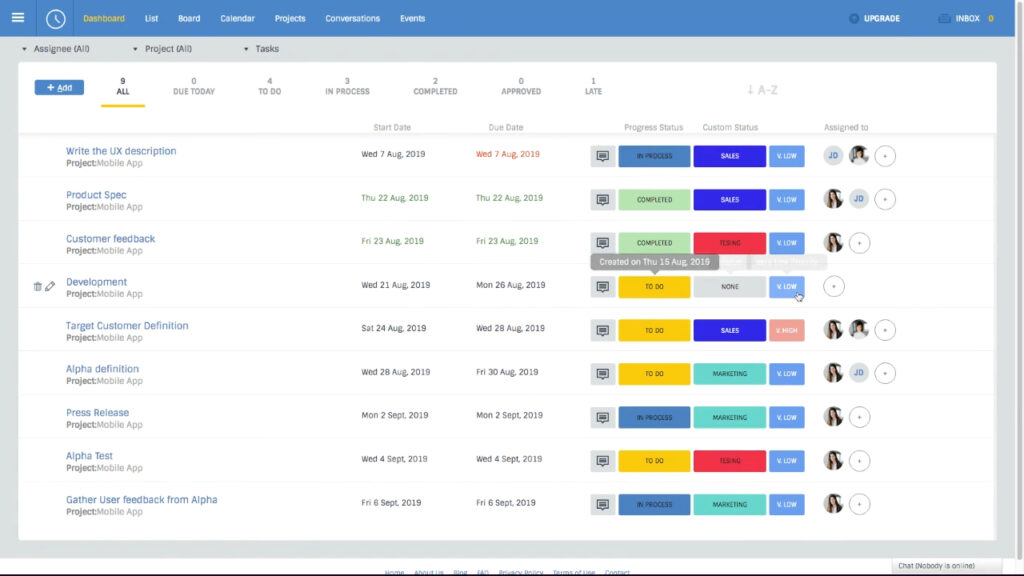
Binfire, a dynamic project management tool, is meticulously designed to cater to the intricate needs of software development teams, particularly those involved in agile project management. This comprehensive project management software offers a diverse range of functionalities, making it one of the best Jira alternatives currently available in the market.
Key attributes of Binfire include advanced task management features, a Kanban board, and an interactive Gantt chart. These components integrate seamlessly to facilitate complex project management scenarios. Moreover, it encompasses a full suite of collaboration features necessary for efficiently handling both small-scale and large-scale projects.
One of the defining elements of Binfire is its ability to create a virtual office environment. This is particularly advantageous for teams engaged in agile project management, as it allows for effective remote collaboration across various geographical locations. It’s noteworthy that Binfire has successfully been employed for collaborative project management by large remote teams spanning three continents, emphasizing its capability as a versatile project management tool.
Key Features of Binfire:
- Essential for organizing and handling multiple aspects of project management.
- These features facilitate effective task management and scheduling within project management software.
- Interactive Whiteboard and Project Template: Ideal for teams following agile project management methodologies.
- Project Status Report, Interactive Gantt Chart, Activity Stream, and Burndown Chart: These tools are crucial for software development teams dealing with complex project management.
Limitations of Binfire:
- A potential drawback for those seeking extensive connectivity with other applications.
- May present challenges for beginners, especially in comparison with other project management tools.
- An area where Binfire trails behind the best Jira alternatives.
Pricing:
- While Binfire doesn’t offer a free plan, it starts at $6.50 per user per month. Those interested in exploring its capabilities as one of the best Jira alternatives can take advantage of this pricing model to access its comprehensive project management functionalities.
3. Basecamp
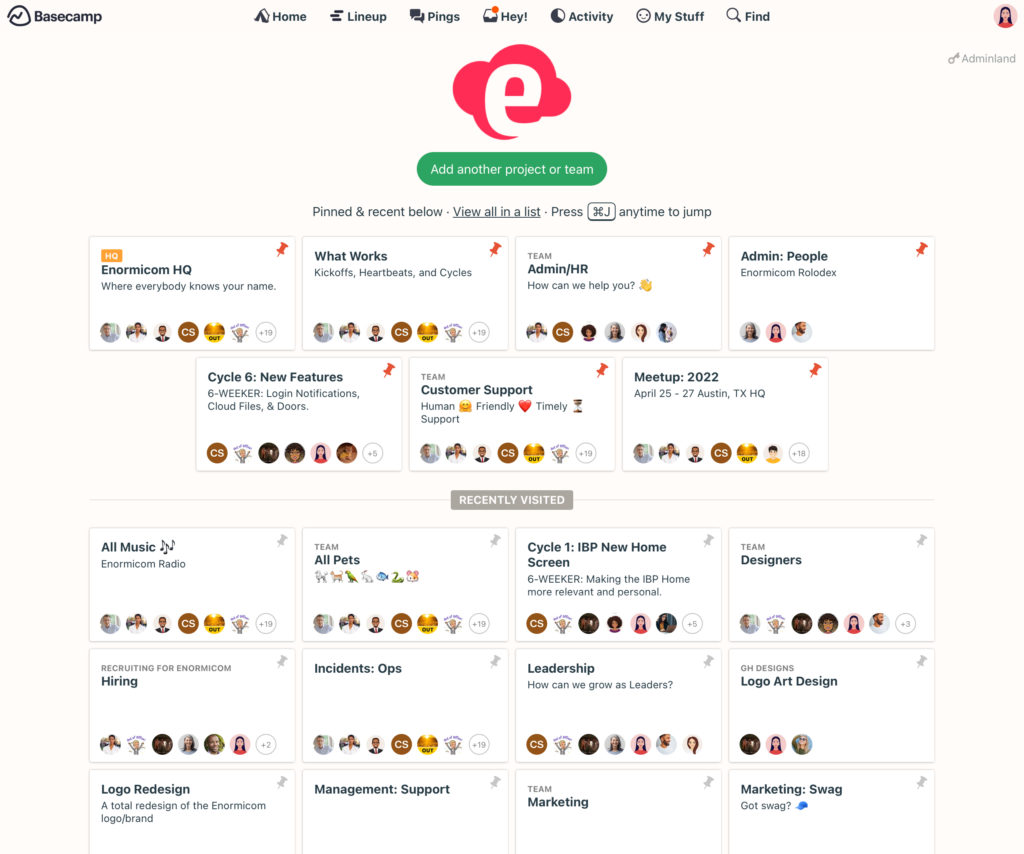
Basecamp stands out as a user-friendly project management tool, adept at uniting diverse roles towards a shared objective. It’s particularly effective for teams that find themselves limited by Jira’s complexity, especially those not involved in developer-centric tasks like bug and issue tracking.
For groups seeking a simple project management solution to collaboratively complete projects, Basecamp emerges as a viable Jira alternative. It offers a flexible pay-as-you-go pricing model, devoid of binding contracts, and includes an annual package option for those who wish to access its full spectrum of advanced features.
A notable advantage of Basecamp is its pricing structure, which is not user-dependent. This means you can involve as many team members as necessary without worrying about additional costs. Upon engagement, users quickly discover Basecamp’s efficiency in task delegation and its prowess in tracking project progress, even across multiple projects.
Basecamp is particularly beneficial for teams dispersed across different time zones, offering capabilities that significantly enhance remote project management. This agile project management software boosts work agility and productivity, seamlessly catering to the needs of diverse project management teams.
Key Features of Basecamp:
- Streamlines communication within the team.
- Facilitates easy access to project materials.
- Ideal for maintaining to-do lists and task tracking.
- Automatic Check-in Questions: Streamlines daily standups.
- Allows clients and customers to view tasks and communicate efficiently.
- Group Chat & Direct Messaging: Enhances team collaboration.
- Task Reporting: Provides insights into task completion and project progress.
Limitations of Basecamp:
- Absence of Time Tracking: A notable omission within the platform.
- Restricts flexibility for tasks and projects.
- Lack of Built-in Dependency Management: A disadvantage for handling complex projects.
Pricing:
- Basecamp offers a complimentary personal plan, with a paid plan priced at $99/month for unlimited users, making it a cost-effective solution for managing multiple projects.
4. Pivotal Tracker
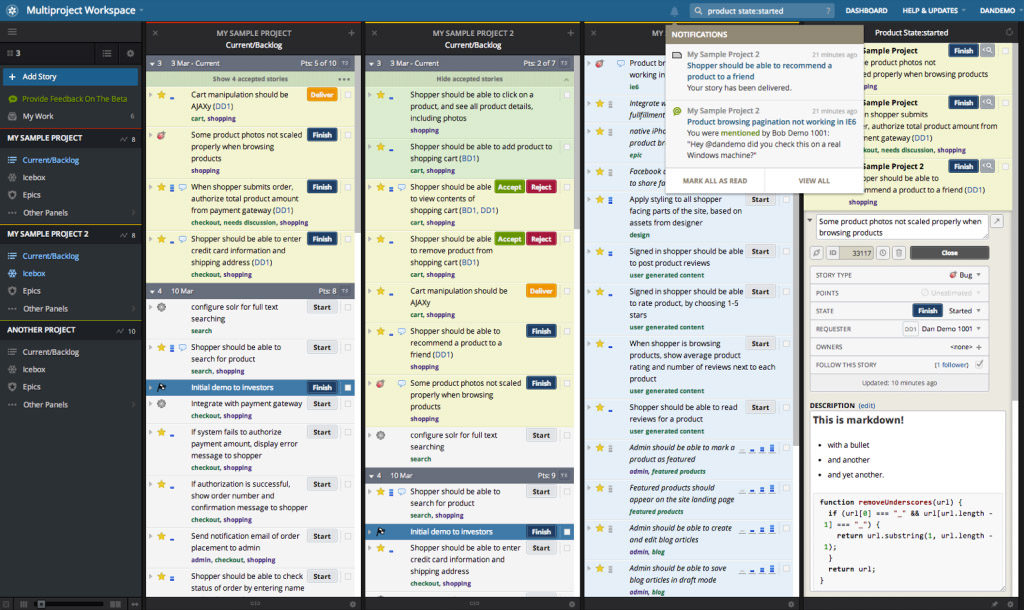
Pivotal Tracker emerges as a prominent agile project management tool, tailored to streamline task management and enhance collaboration within teams. This platform stands out among Jira alternatives, offering a user-friendly interface that focuses on simple project management while packing advanced features.
Key to Pivotal Tracker’s appeal is its ability to provide a unified view of priorities, aiding teams in determining which tasks to address next. As a formidable competitor to Jira, Pivotal Tracker brings forward tools such as backlog lists, features, and hotfixes, simplifying the process of task selection for your agile software development team. A notable feature is the calculation of team velocity, based on story points completed in each iteration, offering a quantitative measure of the team’s progress.
Pivotal Tracker further supports planning with its guided tracker tool, enabling teams to segment work into manageable portions, enhancing the ability to track project progress effectively.
Key Features of Pivotal Tracker:
- Aid in estimating and prioritizing work collaboratively.
- Ensures a streamlined workflow.
- Allows efficient management of various projects simultaneously.
- Tracks time and trends, providing crucial insights.
- Facilitates iterative planning and task tracking.
Limitations of Pivotal Tracker:
- Not ideally suited for non-agile or large-scale projects.
- Some users may find the interface cluttered and less intuitive.
- Limited reporting features restrict the generation of detailed insights.
Pricing:
- Pivotal Tracker offers a free plan for up to five users, making it an accessible option for smaller teams. For larger teams, the paid plans begin at a reasonable $10 monthly flat rate. This pricing structure, combined with the option for a free trial, makes Pivotal Tracker an attractive choice for those seeking efficient and budget-friendly project management tools.
5. Asana
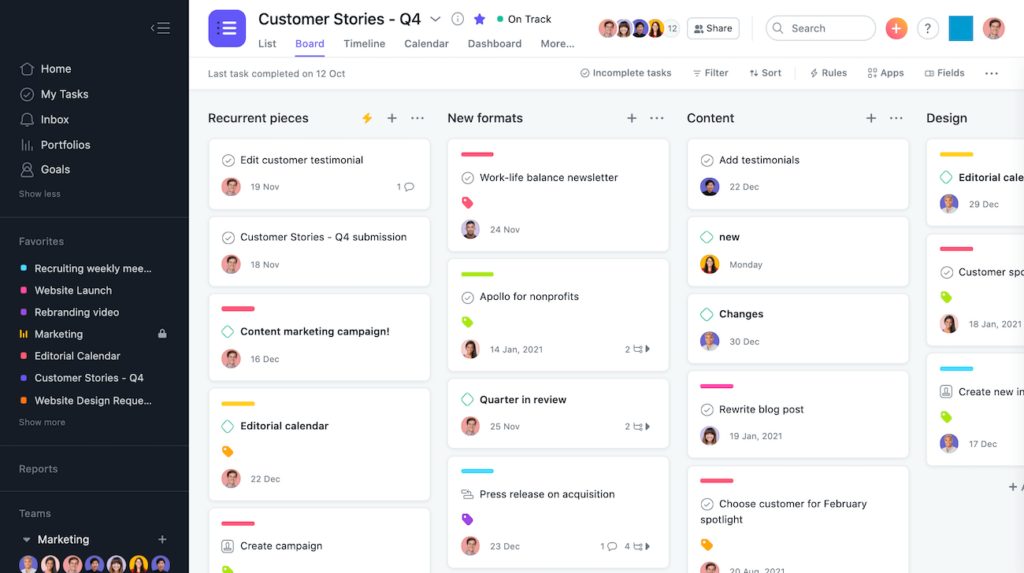
Popular among agile teams for its comprehensive project management features. Serving as an effective alternative to Jira, Asana excels in facilitating communication and collaboration across project management teams.
Asana is equipped with a kanban style board view, making it an ideal choice for visual project management. This feature, along with workflow automation capabilities, greatly aids in organizing tasks and streamlining project planning. The platform’s ability to handle task dependencies enhances its utility for more complex project management scenarios.
Among Asana’s notable features are its multiple workspaces, enabling users to assign tasks, attach relevant documents, and engage in real-time collaboration. Its transparency, showcased through the visibility of co-workers’ tasks and priorities, is crucial for the agility and efficiency of any project. Moreover, Asana’s adaptability across various devices and browsers allows for continuous tracking of project progress.
Asana diminishes the reliance on third-party applications or emails for corporate communications. By leveraging this project management system, teams can significantly improve workflow efficiency, task management, and overall project execution. Asana also stands out for its dedicated tech support, readily accessible through various communication channels.
Key Features of Asana:
- Multiple Workspaces: Facilitate efficient project management.
- Keep track of all project activities.
- Provide easy reference to important documents.
- Calendar View: For effective time tracking and deadline management.
Limitations of Asana:
- Lack of Built-in Chat: Misses real-time chat functionality for immediate collaboration.
- Limited Advanced Features in Free Plans: Timelines and custom fields are exclusive to paid subscriptions.
- Scope of Projects: More suitable for simple project management, and may not be ideal for handling highly complex projects.
Pricing:
- Asana offers a free plan. Their paid plans start from $10.99/user per month.
6. Shortcut
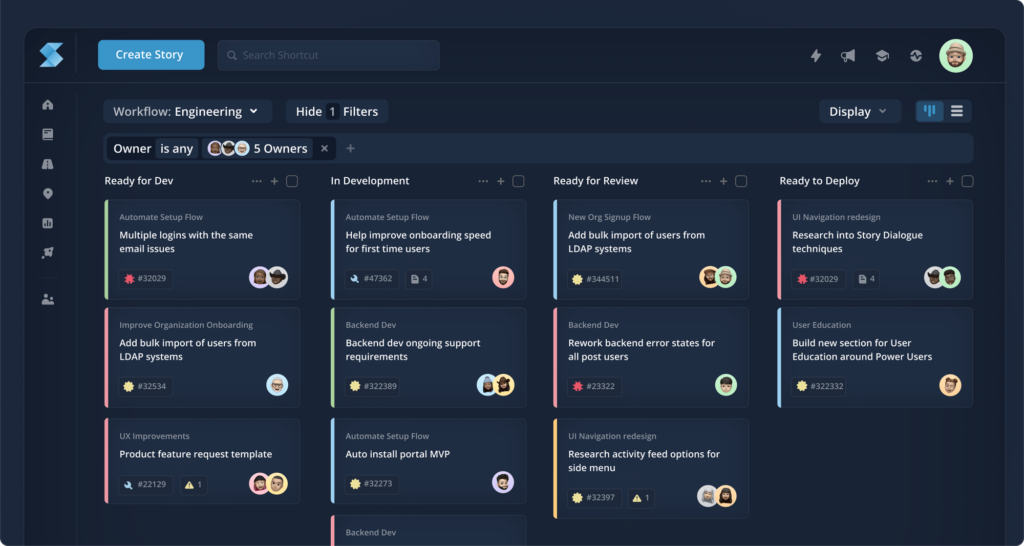
Shortcut, formerly known as Clubhouse, has rapidly gained popularity as a Jira alternative, largely due to its user-friendly interface which maintains the project management functionality akin to Jira, but with a more streamlined presentation.
This tool simplifies task tracking and project organization while avoiding the often cluttered and dated feel of Jira’s interface. Shortcut’s approach starts with the concept of a “story,” allowing users to incorporate tickets, bugs, or chores, thereby shaping the narrative of their project.
In addition to its straightforward interface, Shortcut provides an array of project templates and visual aids like Gantt charts, enhancing its utility in organizing tasks and time tracking. The software also includes a variety of charts for effective monitoring of burndowns and estimates.
Key Features of Shortcut:
- User-Friendly Interface: Eases navigation and task management.
- Facilitates collaboration and documentation.
- Reporting Dashboards and Progress Reports: Offers insights into project status.
- Extensive API: Supports the creation of open-source projects.
- Compatible with Github, Bitbucket, Slack, and more.
- Knowledge Base Feature (Beta) – A new addition to its suite of tools.
Limitations of Shortcut:
- Limited Integrations, this may pose challenges in achieving a seamless workflow management.
- New users might find the interface somewhat cluttered.
- Compared to other project management tools, Shortcut offers fewer customization possibilities.
Pricing:
- Clubhouse offers a free plan. Their paid plans start at $8.50/user per month.
7. ProofHub
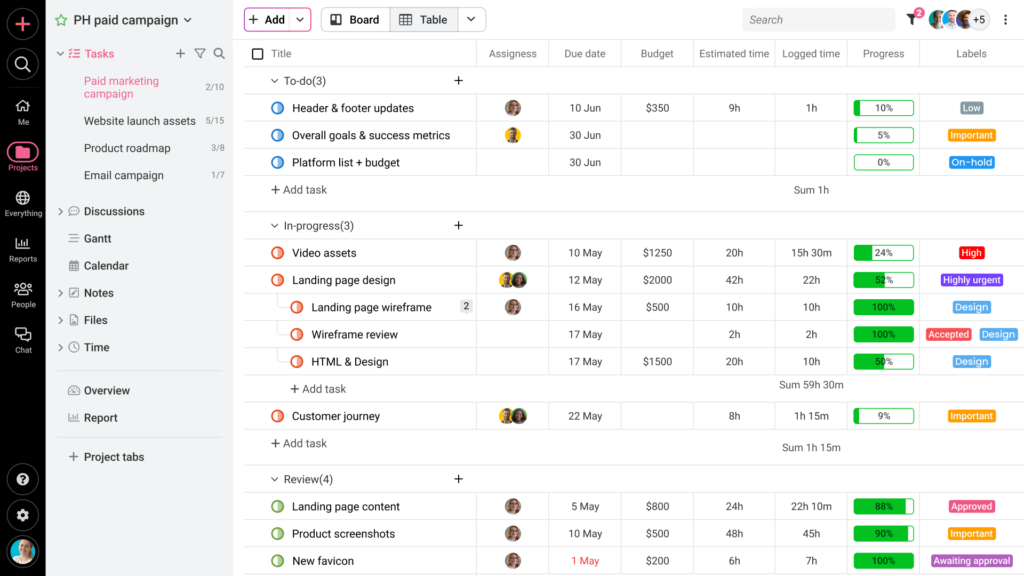
ProofHub emerges as a popular project management tool and an excellent Jira alternative, renowned for its versatility in managing teams and projects with enhanced efficiency. This platform excels in task organization and provides a cohesive approach to service management, encompassing various essential features.
Central to ProofHub’s appeal is its ability to serve as a unified source for task management, offering straightforward to-do lists, agile workflows, kanban boards, and Gantt charts for visual project timelines. This comprehensive suite of tools enables teams to efficiently organize tasks and track progress, while its built-in chat app consolidates office communications in one location. Additionally, ProofHub’s online proofing tool streamlines the review and feedback process, enhancing collaboration.
Another significant aspect of ProofHub is its capabilities in resource management. It offers a dedicated space for real-time discussions and custom reports, facilitating better oversight and management of both projects and resources. Integration with third-party applications like Google Drive, OneDrive, Dropbox, and Box further enhances its utility by centralizing access to all project-related data.
Notably, ProofHub’s user-friendly interface stands out as one of its best features, ensuring a smooth onboarding experience. With minimal learning curve, new users can quickly adapt to its system.
Key Features of ProofHub:
- To-Do Lists – Streamlines task management.
- Custom Workflows and Kanban Boards: Offers flexibility in project execution.
- Gantt Charts: Aids in detailed project planning.
- File Management: Organizes project files effectively.
Limitations of ProofHub:
- No Personalized Workspace Options – this might limit user experience customization.
- Limited Integration Range: Falls short in comparison to other project management tools.
- User Interface Challenges: The interface may not be as intuitive as some of the best Jira alternatives.
Pricing:
- Simple, no per-user pricing. The Ultimate Control plan with unlimited users and projects available at $89/month (billed annually).
8. Notion
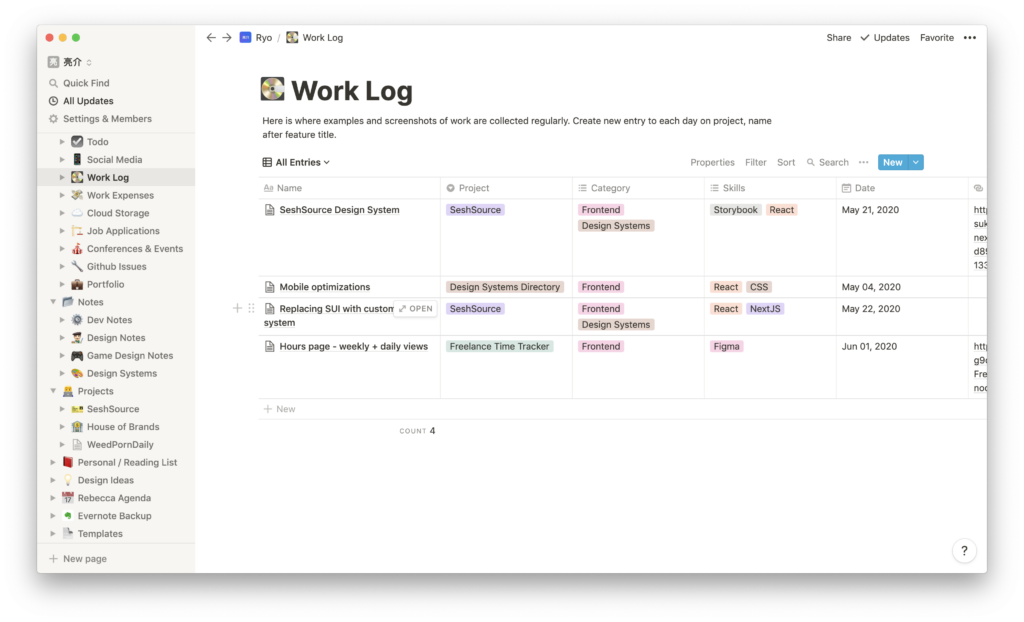
Businessmap positions itself as one of the best Jira alternatives, particularly for those seeking to manage multiple projects and streamline workflows. This agile project management tool enables teams to efficiently visualize key initiatives and break them down into manageable tasks using intuitive kanban boards.
The software offers an array of features designed to enhance managing tasks, including Work In Progress limits, filters, role-based access, and customizable fields. These elements allow teams to adapt the visualization of work to their specific preferences. Businessmap’s versatile kanban boards are ideal for creating and managing multiple custom workflows, while the timeline workflow feature provides an alternative approach to project planning.
Additionally, Businessmap facilitates time tracking, enabling users to monitor hours spent on tasks or projects. This is complemented by comprehensive analytics that aid in performance monitoring.
Key Features of Businessmap:
- Custom Workflow Analytics: Provides insights to measure team and project performance.
- Timeline Planner – assists in creating detailed project roadmaps.
- Multiple Workflow Management: Enhances the ability to organize and manage various tasks.
- Visual Performance Tracking: Utilizes tools like cumulative flow diagrams and cycle time heatmaps.
Limitations of Businessmap:
- The extensive features and complex interface may be overwhelming for smaller businesses.
- The lack of extensive integration capabilities can restrict collaborative efforts.
- New users may find it challenging to navigate and utilize the software’s complex functionalities.
Pricing:
- Businessmap has a standard plan that costs $149/month.
9. Smartsheet
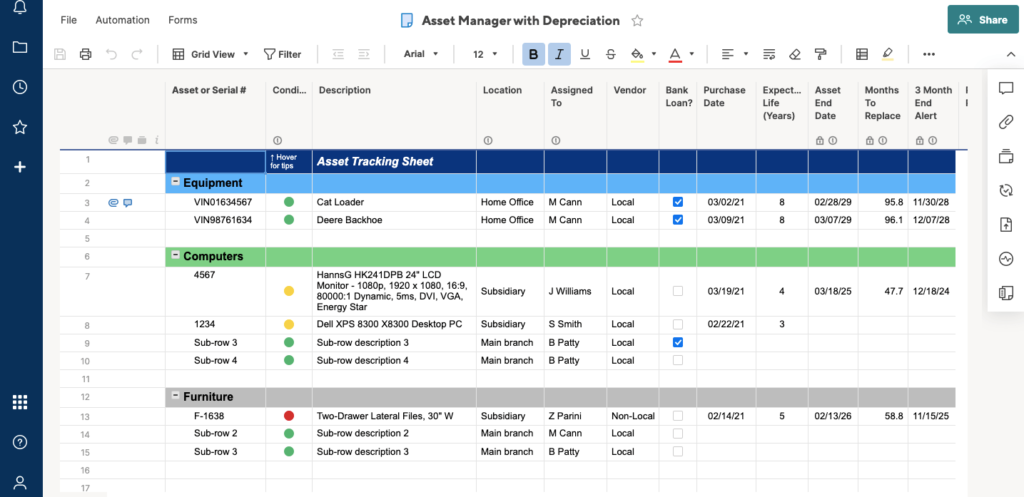
Smartsheet stands out as a comprehensive cloud-based collaboration software, adeptly catering to the needs of project managers who prefer a spreadsheet-style approach but require more advanced functionalities. As one of the best Jira alternatives, it offers an attractive, modern interface, coupled with flexible and powerful features to streamline project management.
Key Features of Smartsheet:
- Visual Timelines/Gantt Charts: Facilitate mapping out task dependencies and critical paths, essential for effective project planning.
- Significantly reduce manual tasks and enhance efficiency, particularly in handling repetitive tasks.
- Simplify data collection and management, aiding in efficient tracking tasks.
- Reports and Dashboards: Provide crucial insights and support informed decision-making with robust reporting capabilities.
- Task Assignments: Enable clear and organized task allocations among team members.
Limitations of Smartsheet:
- Spreadsheet-Based Format: While unique, it may not appeal to all users, especially those looking for a more traditional project management tool.
- Limited Third-Party Integrations might impede collaboration efficiency for teams reliant on extensive integration capabilities.
- The available customization options might not fully satisfy specific, tailor-made project management requirements.
Pricing:
- There are three price tiers, including a free trial. Paid plans start at $7 per user per month.
10. Monday.com
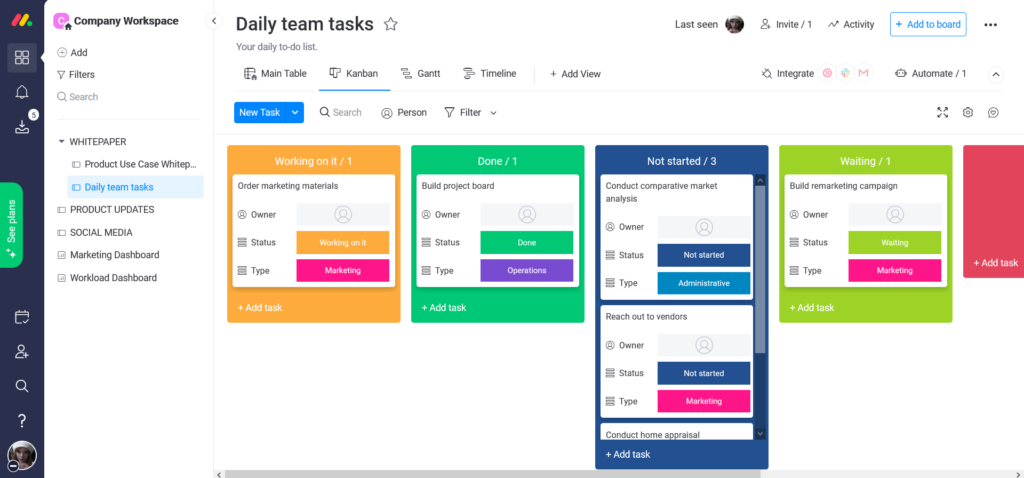
Monday.com is widely recognized as a versatile cloud-based collaboration software, making it an ideal choice for agile businesses and a flexible alternative to Jira. Praised for its user-friendliness, Monday.com caters to a diverse range of teams and industries, offering features that streamline work management. It allows project managers to easily customize views, track tasks, and generate detailed reports, enhancing overall efficiency and data management.
Key Features of Monday.com:
- Open API Architecture: Facilitates seamless integration with various systems.
- Native Integrations: Ensures compatibility and smooth workflow across different platforms.
- Detailed Reporting: Enhances reporting capabilities, allowing for comprehensive analysis and tracking of tasks.
Limitations of Monday.com:
- Learning Curve: The platform may present a steep learning curve, which can be challenging for individuals less familiar with tech-heavy interfaces.
- Limited Functionality in Free Version: The basic plan may restrict access to advanced features, which might be a concern for budget-conscious users.
- Customer Support: Slower response times in customer support could impede prompt resolution of issues, impacting user experience.
Pricing:
- Monday’s free plans start at $12/month per user for the basic plan.
11. Backlog by Nulab
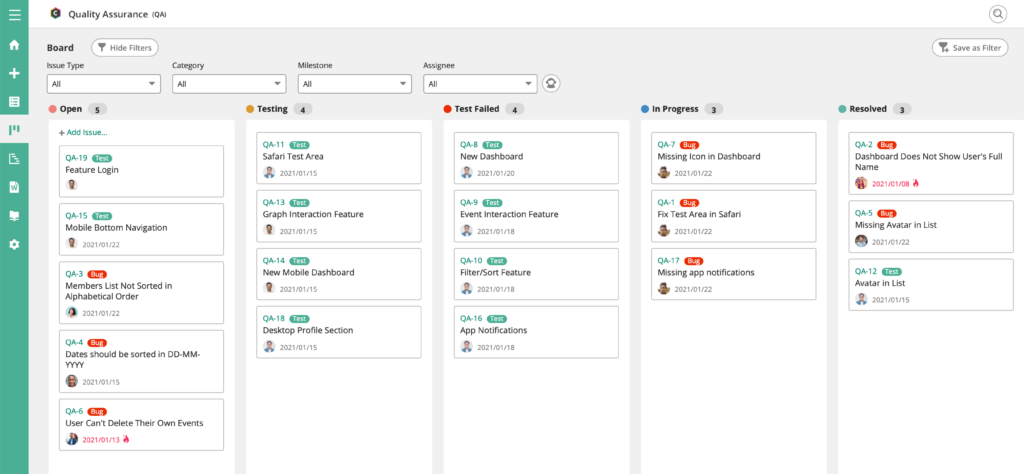
Backlog stands out as a project management tool specifically designed to prioritize and track work, featuring a user-friendly interface that facilitates enhanced team collaboration, particularly among development teams.
Key Features of Backlog:
- Git Hosting & Private Git Repository: Offers secure and efficient code management.
- Enables visual planning with gantt charts and tracking of project timelines.
- Wikis – provides a centralized space for team knowledge and documentation.
- Allows personalization to meet specific project requirements.
- Streamlines the process of reporting and tracking bugs.
Limitations of Backlog:
- Lack of Integrated Chat Functionality: Necessitates the use of additional tools for team communication.
- The interface may present navigational difficulties, especially for those without a technical background.
- Backlog might not fully meet the demands of more intricate project management scenarios.
Pricing:
- Backlog plans start at $29.17/ month for up to 30 users and go up to $145.83/ month for unlimited users.
12. Bitrix24
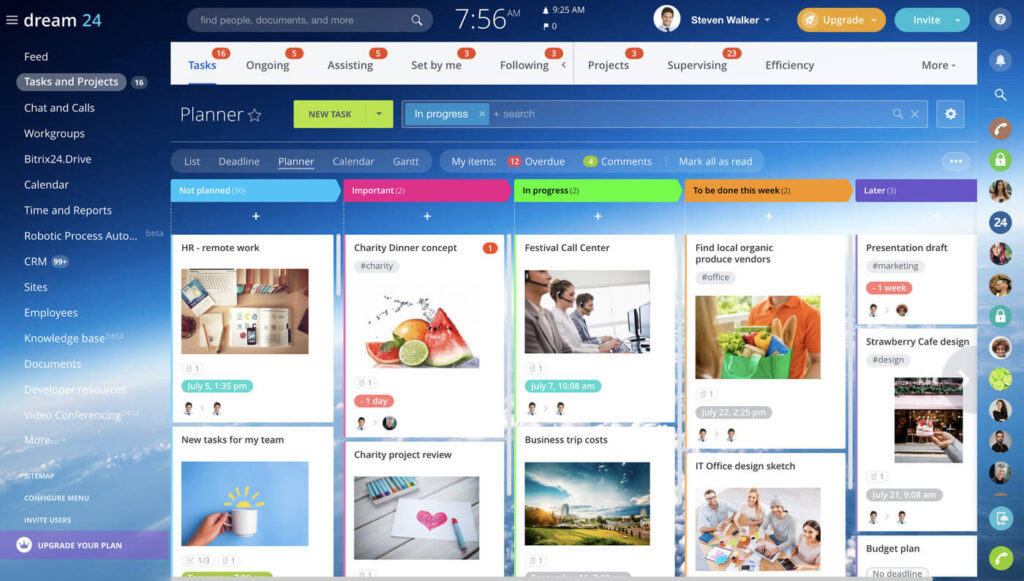
Bitrix24 is a comprehensive social enterprise platform that seamlessly integrates project management, CRM, and communication tools into a single cohesive system. It’s designed to streamline task management and enhance collaboration, making it suitable for both small teams and large organizations.
Bitrix24 is remarkably versatile, catering to various departmental needs including sales, marketing, management, HR, legal, and customer service. Its flexibility and broad functionality make it an ideal choice for diverse business operations.
To delve deeper into what Bitrix24 has to offer, consider exploring our detailed review of the platform.
Key Features of Bitrix24:
- Intranet, chat, video conferencing, and calendars facilitate internal communication and scheduling.
- Comprehensive Workspaces and Tasks Management: Enhances task organization and performance tracking.
- Streamlines document handling and storage.
- Attendance Management and Work Reports: Supports effective system management with workflow automation.
- Monitors work hours accurately.
- Offers a variety of adaptable templates for different business needs.
Limitations of Bitrix24:
- Some users experience limitations in mobile app functionality and find it less user-friendly.
- The CRM features, while robust, could offer more in terms of customization and flexibility.
- Costs may escalate with additional users and the need for extended functionality.
Pricing:
- Bitrix24 has paid plans starting from $24/ month for two users. They also offer a free plan.
13. Wrike
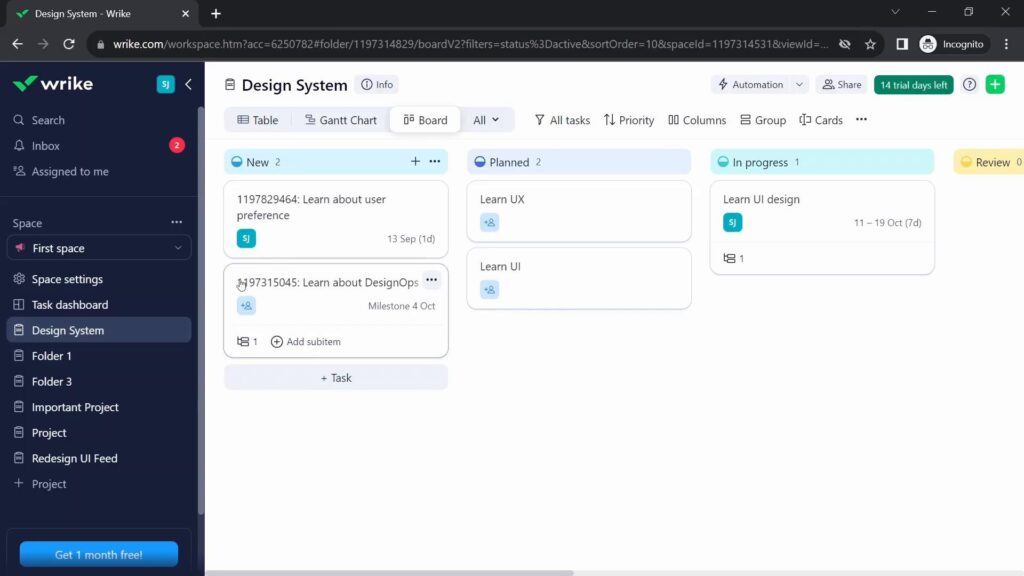
Wrike stands as a sophisticated project management tool, akin to Jira, designed to cater to the nuanced needs of mid-sized and enterprise-level teams. Its primary focus is on simplifying planning, enhancing visibility, and streamlining workflows, making it a viable option for a wide range of project management styles, including both waterfall and agile methodologies.
As a cloud-based collaboration software, Wrike offers extensive customization options, allowing teams to tailor their workflow and enhance productivity. It features Gantt charts and robust reporting capabilities to keep track of team progress efficiently.
For those considering alternatives, it’s worth exploring other options comparable to Wrike.
Key Features of Wrike:
- Customizable Dashboards: Offer tailored views for different project needs.
- Workload Charts for Resource Management: Enable effective allocation and management of team resources.
- Support for Time Tracking, monitoring the time spent on various tasks.
- Facilitate better teamwork and financial planning.
- Organized Dashboards with Drag and Drop Functionality: Simplify task organization and management.
- Streamline the creation of various types of reports.
Limitations of Wrike:
- The basic plan offers limited functionality, requiring premium plans for full access to features.
- Complex Interface: May pose challenges to first-time users, adding a learning curve to the platform.
- Lack of Native Time Tracking: Absence of this feature within the platform necessitates external solutions for time tracking.
Pricing:
- Wrike offers a free plan, and the paid plans start at $9.80/user per month.
14. Linear
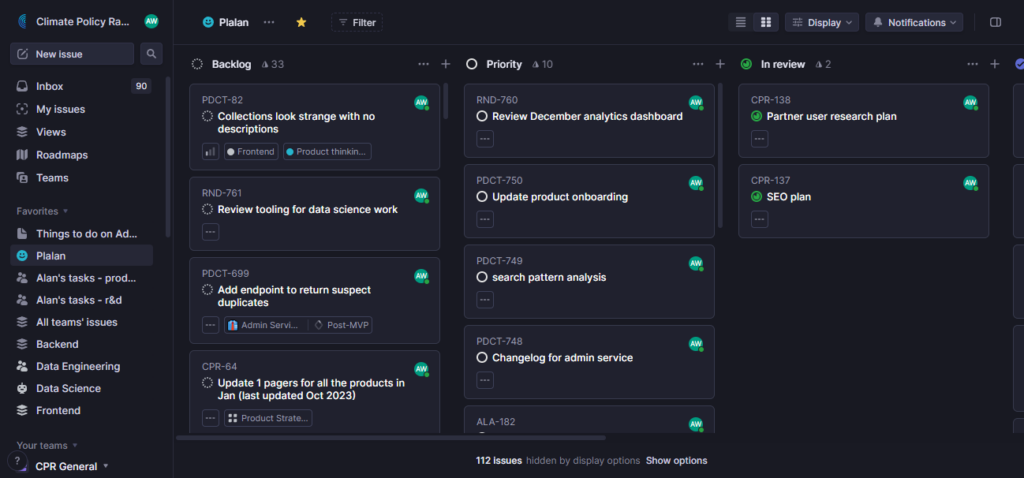
Linear presents itself as an efficient issue tracking tool, specifically designed for software development teams. With its user-friendly interface, Linear aids teams in planning their projects, thereby enabling better decision-making and expedited execution.
The platform’s strength lies in its automated workflows that integrate seamlessly with Git, creating an optimized routine for high-performance outcomes. Particularly suited for smaller teams, Linear streamlines processes for projects that do not demand extensive tracking.
Key Features of Linear:
- Streamlines processes, enhancing team efficiency.
- Git Integrations – Facilitates smooth collaboration and code management.
- Custom Views: Allows personalization to suit specific team requirements.
- Advanced Filters: Enables precise filtering for task management.
- Powerful Search Capabilities: Provides robust search options to quickly locate necessary information.
Limitations of Linear:
- The range of integrations with other popular productivity and management tools is somewhat constrained.
- Focus on Software Development: While ideal for software teams, its feature set may not be as suitable for teams in other domains.
- Lack of Gantt Charts and Visual Timelines: The absence of these tools limits capabilities for elaborate visual project planning.
Pricing:
- Linear offers a free plan, and their paid plans start at $8.00/user per month.
15. Trello
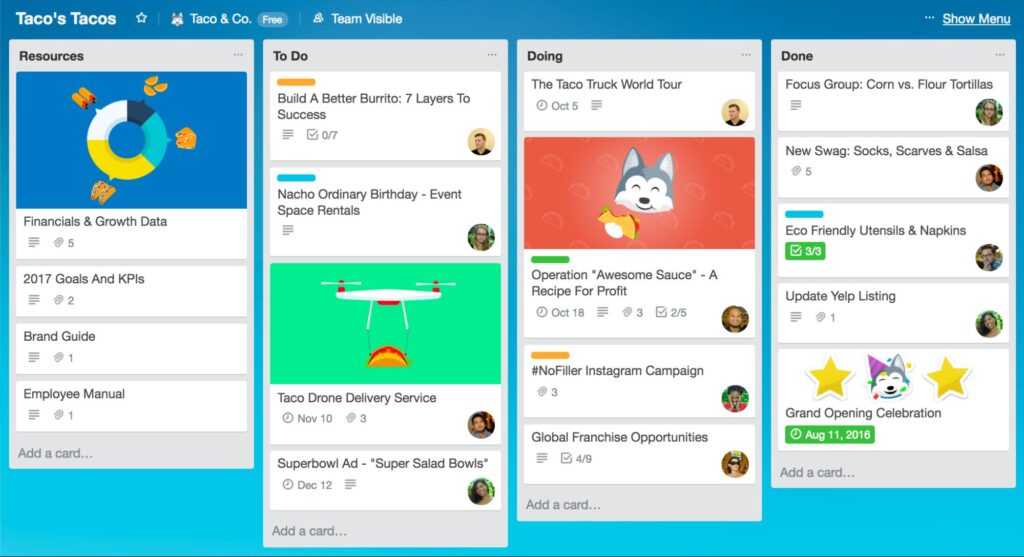
If you’re seeking a project management tool with a simpler board view than Jira, yet still appreciate the card and status update system, Trello might be an excellent choice. Interestingly, Trello is also under the Atlassian umbrella, just like Jira. However, it’s distinct from being just a ‘Jira Lite’.
Trello offers a streamlined approach, ideal for smaller software development teams aiming to manage multiple projects without the complexity of features like story points or issue tracking. It allows the creation of various boards for backlogs, sprints, or upcoming iterations, making it a practical solution at a reasonable price.
A notable aspect of Trello is its power-ups, which allow the addition of functionalities like burndown charts or Gantt charts. These features can be integrated as your team’s needs evolve, without the necessity of an initial commitment to them. All these functionalities are available within an intuitive interface that is user-friendly and engaging.
However, Trello does have its limitations. It confines users to a board view, potentially overlooking the advantages of list or time views for some users. Additionally, cards can become cluttered with comments, which might make alternatives like ClickUp more suitable for certain needs.
Explore top Trello alternatives to understand why options like ClickUp might be a better fit for your project management requirements.
Key Features of Trello:
- Tags, Labels, and Categories – aid in organizing and categorizing tasks.
- Drag and Drop Cards: Simplify task management and prioritization.
- Progress Charts: Offer visual representations of project advancement.
- Set Reminders: Ensure timely task completion.
- Kanban Board View: Enhances task visualization and tracking.
- Task Assignments: Facilitate clear distribution of responsibilities.
- Broad Integration Options: Increase the tool’s versatility and functionality.
Limitations of Trello:
- Restricted Reporting and Analytics: Limits the ability to measure project progress comprehensively.
- No Built-in Time Tracking: This could be a disadvantage for larger teams or more complex projects.
- Limited Free Plan Power-Ups: The free version constrains the use of Trello’s integrations, potentially impacting project management efficiency.
Pricing:
- Trello pricing ranges from free to $17.50/user per month.
16. Clickup
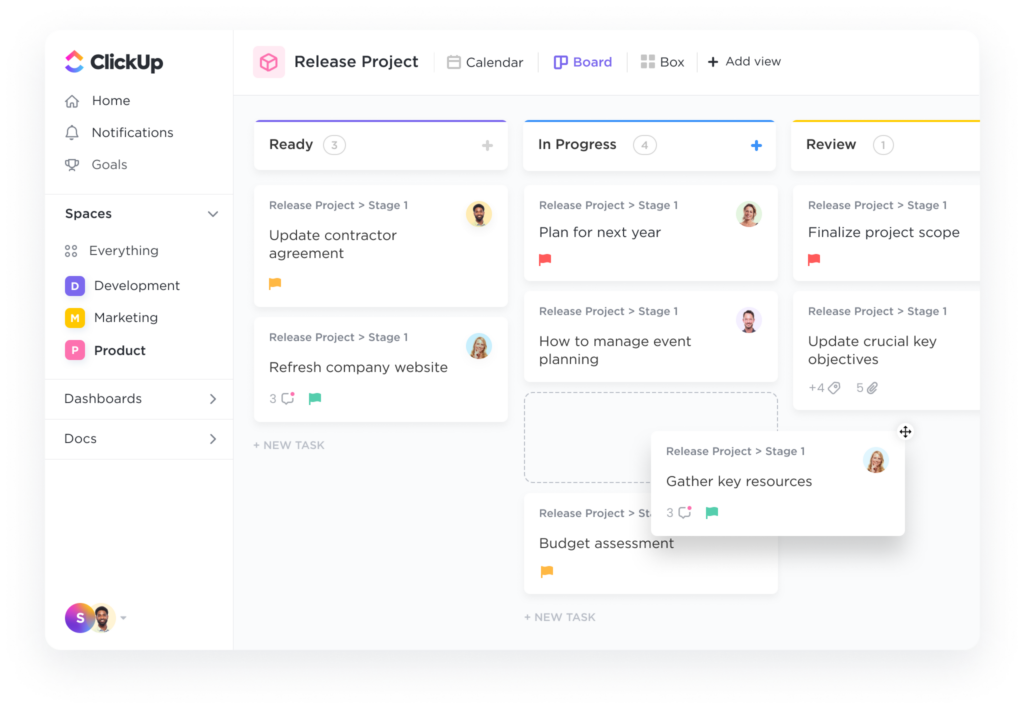
For aficionados of AI-driven content creation, project planning, and email management, ClickUp emerges as a robust alternative to Hive, bolstered by a powerful AI-powered assistant. ClickUp transcends the boundaries of conventional project management tools by integrating AI to enhance content generation within ClickUp documents, streamline project planning, and efficiently summarize email threads. Furthermore, ClickUp’s well-structured task hierarchy, featuring spaces, folders, and lists, adeptly facilitates the organization and segmentation of extensive projects – a domain where Hive sometimes struggles.
Key Features of ClickUp:
- Customizable Task Segmentation: Allows for breaking down projects into manageable tasks, clarifying objectives and facilitating execution.
- Over 15 project views are available, offering varied perspectives to monitor progress effectively.
- Advanced Collaboration Tools: Includes whiteboarding, document management, and proofing for enhanced team interaction.
- Custom Reports and Dashboards: Provide a comprehensive overview of projects and tasks, supporting informed decision-making.
Limitations of ClickUp:
- The extensive array of features can overwhelm and confuse new users.
- Some users report reliability issues with the tool.
- There have been instances of unsatisfactory experiences with customer support as reported by users.
Pricing:
- ClickUp pricing ranges from free to $12/user per month.
Why Look for a Jira Alternative?
- The program is quite sophisticated and full of inefficiencies. Teams responsible for project management have found the customization choices to be a laborious procedure after trying them. The very complicated user experience design of Jira will be a turnoff for anyone trying to increase productivity. Learning how to utilize this interface effectively requires some time and effort.
- Furthermore, Jira’s shortcomings are particularly evident when tasks call for several people to complete. Multiple assignees are not supported by the program. In actuality, participants become observers of the task, offering feedback and addressing problems. But this is disorganized and ineffective since you wind up with two lists: the team really working on the issues and the official Jira assigned person.
- Things might get a little more difficult if you decide to switch from Jira to another free project management tool. Simply attempt to look through their knowledge base sites in search of an exporting option. There won’t be any exporting available—only importing solutions. Alternatively, it might direct you to the Atlassian Jira Marketplace, where you can download apps for various Atlassian products. Moreover, there are plugins that facilitate Jira migration from other programs, not the other way around. Even worse, because they are discontinuing their server solutions, they are now requiring you to relocate to the cloud!
- The price is set in stone. Jira’s cost is a major turnoff. It’s pricey in comparison to a number of simpler, superior project management programs, which suggests that if your team expands, the expense may go even further. Numerous disadvantages of the free plan include lack of capacity planning, automation restricted to a single project, and inadequate dependency management. Furthermore, there isn’t much of a change even if you move from the free plan to the regular plan ($7/user per month). The one site restriction, project-specific automations, and fundamental functionality will all stay the same.
The Kanban technique provides an easy-to-use and efficient task and project management system. It is predicated on two principles: workflow visualization and task limit imposed on the amount of ongoing jobs. By adhering to these two guidelines, you can complete your activities considerably more quickly and save the time you would typically spend organizing yourself.
A project management tool called a Kanban board is arranged into columns to assist teams in seeing how much work is still unfinished. Before it reaches the Done column, a card that represents the task travels from left to right through each column that represents the workflow progress. Free kanban board software revolutionizes task management and project organization. This efficient kanban tool, based on the principles of workflow visualization and limiting ongoing tasks, streamlines the management process. With a free kanban board, tasks progress visibly from left to right, aiding teams in tracking unfinished work and moving towards completion.
Why does that make sense?
Reducing the number of work in progress is based on the theory that if you only work on one activity at a time, you will be forced to concentrate completely and complete each task more effectively. Furthermore, you save a ton of time because you’re constantly focused on what you’re doing, as opposed to juggling multiple tasks and wasting time on them. The strategy behind reducing ongoing tasks with kanban boards is simple yet effective. By concentrating on a single task at a time, you enhance focus and efficiency, a core advantage of using free kanban tools. This approach not only boosts productivity but also saves significant time, a key benefit of kanban software.
How brilliant is Kanban?

You can use free Kanban boards to more effectively organize your daily personal tasks and work. They’re all available online and always reachable from any location. In the event that you happen to remember a task while walking your dog, you can easily add a new task from your smartphone to your Kanban board. Your chores are always with you, ready to be arranged for whenever you’re ready to get to them, whether you’re at work or at home, shopping or on vacation. Free kanban tools stand out for their accessibility and user-friendliness. Whether you’re using a free kanban board at home or a kanban board at work, these tools are always accessible online, making them ideal for managing projects anywhere. This flexibility ensures that, regardless of your location, your tasks are always organized and within reach, enhancing the effectiveness of task management with kanban software.
Using a free Kanban Tool board has the following advantages:
- Greater organization in both your personal and professional life
- Access to your tasks at any time and from any location
- Significant time and effort savings as you eliminate the need to plan and switch between jobs.
- Flexibility: It readily adjusts to your demands, so there are no limitations to what you can do with it or how you operate.
- Never miss a deadline again, which include priorities and due dates. Managing deadlines and obligations will become second nature.
- Process simplification: Because Analytics allows you to track your progress, it’s never been simpler to identify the mistakes you make most frequently and where you can improve. You will benefit from increased productivity and more time off overall from this!
The 20+ best Kanban apps to visualize work in 2024
Teamplate

Teamplate, a dynamic free kanban board software, integrates key business tools into a comprehensive kanban tool platform. This advanced kanban software facilitates high-performance collaboration with features like Chat, Video Calls, Board, Calendar, Data Room, and Spaces, establishing an optimal workflow for task management. Ideal for managing projects, Teamplate is a versatile free kanban tool designed to efficiently handle your team’s varied tasks.
This kanban board is exceptional in managing complex workflows and collaborative tasks, characteristic of the best kanban boards. With its adjustable hierarchical structure, Teamplate excels at breaking down complicated projects into simpler tasks and subtasks. This feature-rich free kanban board allows teams to effortlessly navigate between different project data views, all through a single, integrated interface.
By leveraging the capabilities of free kanban tools, Teamplate transforms abstract ideas into tangible actions, assisting teams in crafting project schedules focused on key milestones. The ease and efficiency in managing projects provided by this free kanban board software make Teamplate an essential tool for effective task management and project organization.
Teamplate Pros:
- Comprehensive Features: Includes a board for to-do lists, document storage, and combines various functionalities in one platform.
- User-Friendly Interface: Known for its simplicity and ease of use.
- All-in-One Solution: Provides Kanban and checklist functionality, backlog and sprint functionality, and combines tools like Jira, Confluence, and Slack into one.
- Effective for Project Management: Especially useful for managing projects with external clients.
Teamplate Cons:
- Notification System: Current notifications can be easy to miss.
- Work in Progress: Some features are still being developed and can be rough around the edges.
- App Performance: The desktop and mobile apps can be buggier than the browser version and lack the robustness of tools like Jira/Confluence.
Pricing:
- Free
Clickup
ClickUp’s free kanban board software revolutionizes project management by offering a comprehensive kanban tool suite. This platform provides an array of free kanban boards, allowing any team to manage numerous workflows efficiently. With ClickUp, teams can engage in more effective communication and centralize their work on a single kanban board, all at no cost.
The versatility of ClickUp’s kanban software adapts seamlessly to any team size, making it a perfect match for various levels of experience in managing projects. This free kanban tool is designed to streamline task management, offering a user-friendly interface and a range of free kanban tools. Whether you’re a beginner or an experienced professional, ClickUp’s free kanban board is the ideal solution for effectively organizing and tracking projects. With ClickUp, teams gain access to robust kanban boards, enhancing collaboration and productivity without any financial investment.
ClickUp pros:
- Select from 100 built-in connectors or the hundreds of more that Zapier offers to create a comprehensive workflow management system.
- Establish and oversee your individual and team goals on a daily, monthly, quarterly, and annual basis.
- For simple time monitoring, use the ClickUp Chrome extension to record time from your desktop, mobile device, or online browser. It’s free.
ClickUp cons
- Not all ClickUp views are available on the mobile app
Pricing:
- Free Forever Plan (best for personal use)
- Unlimited Plan (best for small teams ($7/member per month)
- Business Plan (best for mid-sized teams ($12/member per month)
- ClickUp AI is available on all paid plans for $5 per Workspace
Paymo
Paymo, a project management tool ideal for small businesses and independent contractors, excels in integrating free kanban board software into its system. This kanban software offers a variety of views, with the Kanban view being especially prominent alongside the List, Table, Calendar, and Gantt features. As a comprehensive kanban tool, Paymo allows for seamless task management and the efficient oversight of various workflows on a single platform.
With its array of free kanban boards, Paymo simplifies the process to manage projects, making it accessible and user-friendly for its users. This free kanban tool is particularly tailored to the needs of small-scale operations, providing all the essential features of kanban boards without any cost. The platform’s free kanban features are an invaluable resource for those looking to streamline their project management processes. Paymo’s free kanban board stands as a testament to its capability to combine professional project management with cost-effective solutions, offering a robust and versatile tool for effective task organization and workflow management.
Paymo pros:
- Workflow customization and detailed cards
- Meta Kanban view for all tasks across all projects
Paymo cons:
- Task dependencies are not visible in the Kanban view
- No Kanban swimlanes, although cards can be group and filtered
Pricing:
- Free forever
- Starter $9.90 – per user/month
- Small Office $15.90 – per user/month
- Business $23.90 – per user/month
Toggl Plan
Toggl Plan, more than just a kanban tool, is among the best free kanban software available, enhancing traditional project management apps with its robust kanban system. This software excels in project planning and tracking, ensuring efficient task completion and delivery. Its kanban board feature provides a clear visual on the task status, a key aspect of its comprehensive project management features.
Ideal for those who value collaboration features, Toggl Plan allows team members to easily drop tasks into different stages and automate tasks, streamlining the workflow process. Its drag-and-drop functionality, coupled with customizable status updates and in-task comments, makes it a top contender for the best free kanban board. This free kanban software offers a blend of simplicity and efficiency, making it a superb choice for managing projects with ease and precision.
Toggl Plan pros:
- Multiple members can be assigned to a task.
Toggl Plan cons:
- No task dependencies (if this feature is non-negotiable for you, check out a few Toggl alternatives)
- Members are limited to two view options: Team timeline or Plan board
Pricing:
- Team $9 – per user/month
- Business $15 – per user/month
Monday.com
Monday.com is not just a kanban tool; it’s a comprehensive project management app that integrates a robust kanban system. As one of the best free kanban boards available, it offers exceptional task management solutions, assisting cross-functional teams in focusing on crucial tasks with ease. This free kanban software is known for its Kanban board views, which greatly enhance task status visibility.
In addition to its basic kanban features, Monday.com excels in collaboration features, making it a top choice in project management apps. It allows project managers to create real-time project dashboards, a key aspect of its project management features. The platform’s ability to automate tasks and let users easily drop tasks into different stages of the workflow further solidifies its position as a leading free kanban software. Monday.com represents a seamless blend of functionality and efficiency, catering to the dynamic needs of effective project management.
Monday.com pros:
- Unlimited boards and docs in the free plan
- Customizable workflows to easily track projects
Monday.com cons:
- Features are not in-depth compared to other top Kanban board apps on this list
- Dashboards are a paid premium feature
Pricing:
- Free Forever Plan
- Basic – €12 seat/month
- Standard – €14 seat/month
- Pro – €24 seat/month
Asana
Asana, more than just a kanban tool, offers a comprehensive kanban system within its suite of project management apps. Utilizing the kanban method, Asana’s free version stands out as one of the best free kanban boards, enabling teams to manage tasks effectively. It offers flexible kanban boards that cater to the dynamic needs of unlimited users, making it an ideal choice for any project manager.
This free kanban software excels in showcasing task status in real-time, enhancing team collaboration features. Asana’s project management features include the ability to automate tasks and conveniently drop tasks into different project stages. The system ensures that all team members are kept informed with timely notifications as tasks progress. Asana’s implementation of the kanban method in its project management apps makes it a top-tier tool for efficient and collaborative task management.Teams may easily visualize their progress in real time with the help of Asana’s Kanban board features. For instance, a member can utilize the Advanced Search option to narrow their search to certain columns if they are seeking for a particular task. To ensure that everyone is informed, members will also get notifications when tasks progress through sections.
Asana pros:
- Members can perform bulk actions on tasks to save time
- Kanban board view is available on the free plan
Asana cons:
- Only one assignee per task
- Subtasks can be challenging, so members will need to consider finding workarounds for complex projects
Pricing:
- Starter – €10.99 – per user/month
- Advanced – €24.99 – per user/month
Wrike
Small businesses looking for an easily configurable workspace to plan tasks, manage shared calendars, and facilitate collaboration will find Wrike project management software to be perfect. Additionally, approvers can use Wrike’s visual markup tool to accelerate feedback.
Wrike pros:
- Kanban board view allows complete visibility of tasks
- Time tracking feature to compare estimated versus actual time spent
Wrike cons:
- Steep learning curve for new users
- Gantt charts are not available in the free version
Pricing:
- Free Forever Plan
- Team – $9.80 per user/month
- Business – $24.80 per user/month
MaisterTask
A visual project management application based on the Kanban technique is called MeisterTask. Sleek and readily configurable Kanban boards allow team members to effortlessly oversee everyday tasks. Teams may interact and work together throughout the workflow with project management tools like numerous checklists, automation, and infinite sections.
MeisterTask pros:
- Task relationship links (related, duplicate, or blocking) feature to keep project members informed
- Built-in time tracker that comes in handy for team calculations and projections
MeisterTask cons:
- WIP limits, unlimited projects, and reporting are paid features
- One assignee per task
Pricing:
- Basic – Free
- Pro – €11 per user/month
- Business – € 22,50 per user/month
Nifty
Working on large-scale projects with several team members is possible using Nifty. It’s a collaborative workspace that assists you and your team in managing documents, tracking time, and organizing tasks, much like the majority of project management software. When paired with the Kanban approach, members are able to plan, prioritize, and oversee daily tasks in great detail.
Nifty pros:
- Portfolio management feature to view members and statuses at a glance
- Offers different user roles and permissions to control access levels
Nifty cons:
- The free plan is limited to two active projects
- Expensive paid plans to use core features
Pricing:
- Free Forever Plan
- Starter – $39 per person/month
- Pro – $79 – per person/month
- Business – $124 – per person/month
Jira
Jira is a project management and bug-tracking tool designed for technical and agile power users. A development team may have a first column of backlog items that has been ongoing for a while. Jira therefore created a backlog for Kanban development projects and put it to a separate project tab. Teams are aware of what’s next when product managers transfer tasks from the backlog to the board.
Jira pros:
- WIP limits can exclude subtasks from the Kanban board column count to ensure all action items for a specific task won’t be shut out
- Integrations with 3,000+ apps
Jira cons:
- Complicated user interface and migration make managing tasks burdensome
- Teams considering Jira will need to use another software app for simple project management
Pricing:
- Free forever
- Standard $8.15 – per user/month
- Premium $16 – per user/month
Proofhub
With the help of project planning tools like Proofhub, teams can organize every phase of their work and see it as it progresses. Using the Kanban tool, team members may prioritize tasks and observe how work progresses through different phases. It’s an easy-to-use platform for idea sharing and grouping pertinent files.
Proofhub pros:
- Private task lists for assigned people only
- Recurring events and tasks feature
Proofhub cons:
- Lacks budgeting capabilities
- Not a suitable platform for agile project management compared to other top Kanban apps on this list
Pricing:
- Ultimate control $89/month
- Essential $45/month
Businessmap
Within a company, Businessmap automatically reports, updates, and monitors the progress of every project. Teams can concentrate on completing tasks and streamlining procedures thanks to this data. Stakeholders and team members can work together more quickly and effectively with Businessmap.
Businessmap pros:
- Analytic tools such as Cumulative Flow Diagram, Cycle Time Scatter Plot, and WIP Aging chart
- Interlinked Kanban boards on a team and management level
Businessmap cons:
- Not ideal for businesses outside of software and engineering industries
- Setup and configuration may be time-intensive
Pricing:
- Annual Plan $149/month
- Month by Month $179/month
Planview Leankit
Planview Leankit’s adaptable Kanban boards facilitate the sharing of a unified, prioritized, and status picture of work among lean and agile teams. With features like work item history, real-time work status, and WIP limitations, members have all they need to plan and complete project tasks effectively.
Planview LeanKit pros:
- Categorization labels that represent different types of work on a Kanban board
- Complete audit trail of all changes made to a card
Planview LeanKit cons:
- Lack of customization capabilities to cards and custom fields compared to other top Kanban board apps on this list
- Steep learning curve
Pricing:
- Customized
Blossom
Software development teams may examine the tasks of every member of the team by mapping their whole workflow using the Kanban project management tool Blossom. Members may quickly determine whether jobs are blocked or ready for the next step by looking at the colorful “stamps” in the Kanban cards’ corners.
Blossom pros:
- Comments are auto-saved if you navigate and come back to the card later
- The cycle time of Kanban cards is shown on every completed Kanban card
Blossom cons:
- Lacks customization of Kanban boards, cards, task statuses, and team communication
- @Mentions to team members are not a native feature in the platform
Pricing:
- Inquire with Blossom for pricing
Microsoft Planner
Microsoft Planner allows teams to better concentrate and centrally coordinate their work with its integrated Kanban boards and comprehensive task cards. Users of Planner may link to Power Automate, Microsoft To Do, SharePoint, and other apps for effective task management as part of Microsoft 365.
Microsoft Planner pros:
- Android and iOS mobile apps to update tasks on the go
- Attachment preview and link to display on the Planner
Microsoft Planner cons:
- Microsoft Planner as a standalone app isn’t a solution for an all-in-one task management tool
- Less flexibility with customization and integrations
Pricing:
- Inquire with Microsoft Planner for subscription plans
Smartsheet
With Smartsheet, you can plan, organize, and manage several tasks at once. Using drag-and-drop cards, card view is one of four perspectives that facilitates task organization. When enabled, the data in the dropdown list, contacts list, or symbols columns determine how the page is organized into a Kanban board. See our Smartsheet Project Management Guide for further details!
Smartsheet pros:
- Custom branding can be applied to the entire account
- Cards can be reorganized for better prioritization within the same Kanban board column
Smartsheet cons:
- Free plan is limited to 2 sheets and 2 editors
- Not suitable for small agencies
Pricing:
- Free €0 – per user/month
- Pro €7 – per user/month
- Business €28 – per user/month
Pipefy
Pipefy is a low-code/no-code workflow solution. Members may quickly notify stakeholders about their requirements for on-time delivery, automate processes, and integrate technologies. Businesses looking to grow must implement smart processes, and Pipefy offers a full array of project management tools to help teams get going.
Pipefy pros:
- Service portals centralize documents, policies, and request forms
- Native Integrations with Slack, GitHub, BitBucket, and Google Hangouts
Pipefy cons:
- Mid-sized teams will have to pay a high price tag to build a simple Kanban board
- Customization options are paid features
Pricing:
- Free
- Business $20 – per user/month
- Enterprise $34 – per user/month
Flow-e
With Flow-e, job management becomes easier by converting Outlook mailboxes into a visual taskboard, akin to a Kanban process. To track work in progress, members can drag and drop cards from the Flow-e inbox into Kanban columns. One of the app’s extra features is a timeline where users can view meetings and reminders.
Flow-e pros:
- Taskboard with unlimited columns in the free plan
- Standalone task cards in the workflow
Flow-e cons:
- The free plan allows up to two email accounts
- Not suitable for agile teams who need flexible customization features to build their workflows
Pricing:
- Inquire with Flow-e for pricing
Zenhub
Zenhub, an application for agile teams to manage, schedule, and carry out software projects, is the next best Kanban software. Teams may transfer issues between pipelines and give priority to the most important work by using Zenhub Boards in conjunction with a project’s GitHub issues.
Zenhub pros:
- Different teams can use the same GitHub repos across multiple boards
- Workflow automation features automatically sync your project as GitHub issues are updated and completed
Zenhub cons:
- The platform is tailored to software teams
- Works best if connected to GitHub
Pricing:
- Zenhub offers free and paid plans starting at $7.95/user per month
Trello
One well-known Kanban product from the Atlassian software family is Trello. Teams may advance work by utilizing Trello’s personalized card and board buttons, which are made up of four essential parts: the Kanban board, cards, lists, and board menu. The options required to control member permissions, search cards, and build automations are available on the board menu. Members may also add vibrant card covers and board backgrounds to add some fun and flair.
Trello pros:
- The no-code automation feature, Butler, helps teams save time with administrative tasks
- Advanced checklists (a paid feature) for granular task assignments
Trello cons:
- Teams that regularly track multiple projects will need to select a Trello paid plan for unlimited Kanban boards
- Task dependencies are not easy to create or update compared to other top Kanban apps on this list
Pricing:
- Free $0
- Standard $5 – per user/month
- Premium $10 – per user/month
- Enterprise $17.50 – per user/month
Kanban Tool
With the help of the visual management tool Kanban Tool, teams may restrict work-in-progress, cooperate in real-time, and locate and remove bottlenecks. Members may now manage their projects and examine procedures to increase productivity.
Kanban Tool pros:
- One-click collapsible columns and swimlanes, allowing focus on specific areas only
- File attachments with image preview
Kanban Tool cons:
- Customization capabilities are limited compared to other top Kanban board apps on this list
- Not suitable for businesses with 2+ team members
Pricing:
- Free €0
- Team €6 – per user/month
- Enterprise €11 – per user/month
It might take a while to choose the best project management solution, but it doesn’t have to! Sign up for a free teamplate account and take control of your work productivity today!

